Gulf region buys into advanced air mobility
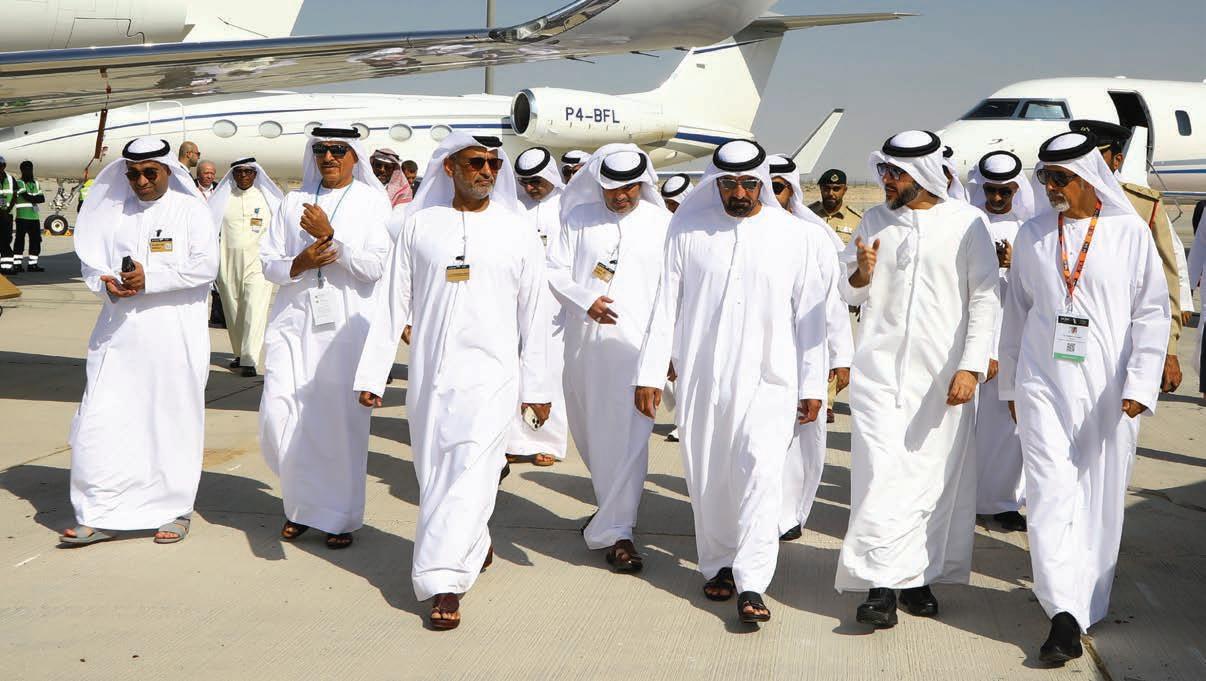 by Charles Alcock
by Charles Alcock
Ambitious, future-obsessed Dubai is just the sort of place you might expect to be an early adopter of so-called advanced air mobility (AAM), including new hybrid- and all-electric eVTOL and eSTOL aircraft used for air taxi services, cargo deliver ies, emergency medical support, and other pub lic-service applications. After some early flight demonstrations a few years ago by eVTOL pio neers Volocopter and EHang, the trail appeared to
go cold, until June when helicopter and business jet operator Falcon Aviation announced plans to launch eVTOL air-taxi services from the luxury resort Atlantis the Palm in 2026.
Under a partnership with Eve Urban Air Mobility, the operator signed a letter of intent to buy 35 of the manufacturer’s planned four-passenger eVTOL aircraft. Falcon believes its track record as a launch operator for sev eral new helicopter types makes it well qualified
FORECAST
MIDDLE EAST
ENERGY
DAY 2 DECEMBER 7, 2022 AINONLINE . COM
continues on page 29 COMPLETIONS VIP Market Growing Citadel Completions is expanding to meet demand for VIP airliner refurbishments | 18
Global Outlook Honeywell’s annual forecast anticipates 8,500 new jet deliveries in the next decade | 20
Useful Tools Dassault sees its products as tools that can help Middle East businesses grow | 26
A Surging World World Fuel Services saw a rapid recovery in the Middle East after the pandemic | 30 MEBAA CONVENTION NEWS
DAVID M c INTOSH
Dubai Civil Aviation Authority president, Dubai Airports chairman, and Emirates Airline chairman and CEO Sheikh Ahmed bin Saeed Al Maktoum leads the royal tour on the opening day of MEBAA 2022.
Up to four of these Global 7500s will fit into Bombardier’s new Abu Dhabi service center, which will be the company’s first such facility in the United Arab Emirates.
Bombardier building its first UAE service center
by Kerry Lynch
Bombardier (Static A19) held a ground-breaking ceremony for a service center at Abu Dhabi International Airport, marking its expansion into the United Arab Emirates, the Canadian business jet manufacturer announced on

opening day of the MEBAA Show.
To open in 2025, the nearly 100,000-sq-ft facility will serve as a key hub for Bombar dier service activities in the Middle East and add more than 100 jobs. With capabilities to service the breadth of Bombardier’s Learjet, Challenger, and Global families, the facility
will have capacity to fit up to four Global 7500s simultaneously.
In addition to the large hangar, the facility will include a parts depot and provide scheduled and unscheduled heavy maintenance, aircraft modi fications, paint modification, aircraft-on-ground capabilities, and aircraft parking services.
“The Middle East is an important market for Bombardier with more than 150 aircraft, and we are pleased to be establishing a highly effi cient facility in the UAE for our customers in the market—and for those visiting from around the world,” said Bombardier president and CEO Éric Martel. “Abu Dhabi is a dynamic financial hub for business and commerce in the UAE, and this service facility will provide significant bene fits, quick aircraft turnarounds, and OEM peace of mind to our growing customer base.”
Jamal Salem Al Dhaheri, managing director and CEO of Abu Dhabi Airports, added, “The presence of Bombardier underlines Abu Dhabi Airport’s commitment to general aviation and is a major step forward to make Abu Dhabi the hub for general aviation in the region.”
While it is Bombardier’s first MRO in the UAE, the Abu Dhabi service center is part of a multi-year global expansion of the company’s service capabilities that is more than doubling its footprint by nearly one million sq ft. z
Celebrating 20 years, Emirates-CAE adding Global 6500 simulator
CAE (Stand 175) is adding a new Global 6500 full-flight simulator (FFS) at the Emirates-CAE Flight Training (ECFT) Al Garhoud center in May, the training specialist announced on the opening day of MEBAA 2022. The addition builds on the breadth of the center’s business aviation reach as CAE and Emirates celebrate the 20th anniversary of their ECFT partnership in Dubai.
“ECFT’s success is a testament to the strong partnership Emirates and CAE have developed over the past 20 years,” said CAE civil avia tion group president Nick Leontidis. “With the deployment of the new Global 6500 FFS, we are securing ECFT’s reputation for delivering the most advanced business aviation training in the region.”
The relationship between Emirates and CAE actually spans 30 years, when the international operator acquired its first simulator, an Airbus A310-300/A300-600R, from the Montreal-based training spe cialist in 1992. By the end of that decade, Emirates had acquired six more simulators, including a custom emergency evacuation trainer, as the airline was rapidly growing.
With that foundation for their relationship, Emirates and CAE formed a training partnership in 2002 to establish ECFT and opened a 12-bay
center the following year. This turned into a formal joint venture in 2006 with the center providing training to Emirates, as well as a growing number of airlines and business aviation operations in the region.
Since then, the joint venture has continued to expand as CAE and Emirates opened a second five-bay center in 2013. Today, the two centers house 19 simulators and train more than 12,000 pilots annually.
“Our consistent investment in infrastructure demonstrates our commitment to providing world-class aviation training in Dubai,” said Steve Allen, executive v-p at Emirates Group. K.L.
Celebrating Emirates-CAE Flight Training’s 20th year are (l-r): CAE’s Camille Mariamo, Emirates training v-p Bader Al Marzooqi, ECFT MD Nimrod Meuleman, and Nick Leontidis, CAE group president.

2 MEBAA Convention News • December 7, 2022 • ainonline.com
DAVID M c INTOSH

www.amacaerospace.com THE PERFECT PLACE FOR BUSINESS AIRCRAFT AUCH • LONDON • BASEL • ZURICH • ISTANBUL • BODRUM • BEIRUT • RIYADH
Bizav panel adds focus to net-zero emissions targets
by Kerry Lynch
While progress continues to be made in sustainable aviation fuel (SAF) availability, carbon offsets are still the first and perhaps easiest means toward sustainability, said Trine Braathen, senior manager of sustainability-carbon markets for World Kinect Energy. But Braathen and other panelists speaking yesterday at a MEBAA Show panel on strate gies for business aviation sustainability agree SAF is key toward meeting the industry’s goals.
Braathen pointed out means for business aviation organizations to become more effi cient but said the biggest step towards net-zero
is addressing fuel. That is what makes SAF so important, she said. But given its limited avail ability, organizations should look at other means, such as offsets, until SAF is more accessible.
Carbon offsets can help enable local organizations address their own footprints until SAF is readily available. Offsets further can pro vide an opportunity under which a financial system could be created for organizations to own and trade them, she maintained.
However, demand for offsets has spiked, pushing up prices. In early 2021, the cheap est offset projects cost less than one euro per
IBAC’s Edwards sets tone for MEBAA Show
International Business Aviation Council director general Kurt Edwards welcomed attendees to the MEBAA Show yesterday, expressing enthusiasm about the return of the three-day event after a four-year, Covid-induced hiatus and stressing that it was time for “setting the record straight.”

“It is so exciting to be back here after four years and I’m really glad to see this turnout. I’m glad to see the number of exhibitors here,” Edwards said kicking o the series of panel sessions MEBAA is hosting on the show floor.
The show is providing a forum for the industry to discuss challenges, opportuni ties business models, financing, regulations, and a range of other pressing issues, he said.
Edwards said one such key issue is
sustainability, adding, “[The industry has] been getting a lot of [negative] press in this area recently” and it’s an issue “we are going to face one way or another.”
Business aviation needs to change the prevailing perception because it “has been striving for sustainability for years. We all want to be more fuel e cient. We all want to use less fuel. We all want to burn less fuel. We’ve been doing that now for decades. Our industry is very innovative.”
He pointed to innovations specific to business aviation, as well as e orts such as commitments to net-zero carbon emissions, and noted that the International Civil Aviation Organization largely adopted a roadmap led by industry. K.L.
tonne. Later that year, the same projects were costing more than nine euros. New players had come into the market to buy up the offsets and sell them back into the market. She cautioned that organizations ensure they select projects by quality rather than quantity of availability.
Meanwhile, SAF is a growing element. Alex andre Geahchan—Air bp’s MENA commercial, general, and military account aviation manager— emphasized, “Its chemistry is quite similar to the fossil jet fuel that it replaces. That’s why it makes a promising solution.”
JetNet iQ managing director Rolland Vin cent said regardless of the means, demand for sustainable options is there. Aircraft owners and operators are interested in good gover nance, he noted, and aircraft manufacturers have been nothing but interested in becoming more sustainable.
Vincent added that he believes regulators will push that along with incentives and taxes and noted these initiatives are already begin ning. While there are several paths currently in the offing, he added, “We love our technology and we’re going to get there with technology that we still don’t even know about.”
Moderating the panel was NBAA senior v-p of safety, security, sustainability, and international ops Doug Carr. “It’s difficult today for us to have a day go by where aviation and sustainability don’t intersect in some way,” he said. “The entire avia tion industry is under a lot of pressure right now from a variety of sectors…to decarbonize. But I believe the spotlight should not be something for us to fear. In fact, it’s going to give us an oppor tunity to highlight all the great work that we are doing to lead the industry towards the goal...of net-zero carbon emissions by 2050.”
4 MEBAA Convention News • December 7, 2022 • ainonline.com
z
DAVID M c INTOSH
L-R: Doug Carr, NBAA senior v-p; Alexandre Geahchan, Air bp Mena commercial, GA, and military account manager; Trine Braathen, World Kinect senior manager; and analyst Rolland Vincent.
Performance enhancing solutions for simpler and safer operations.
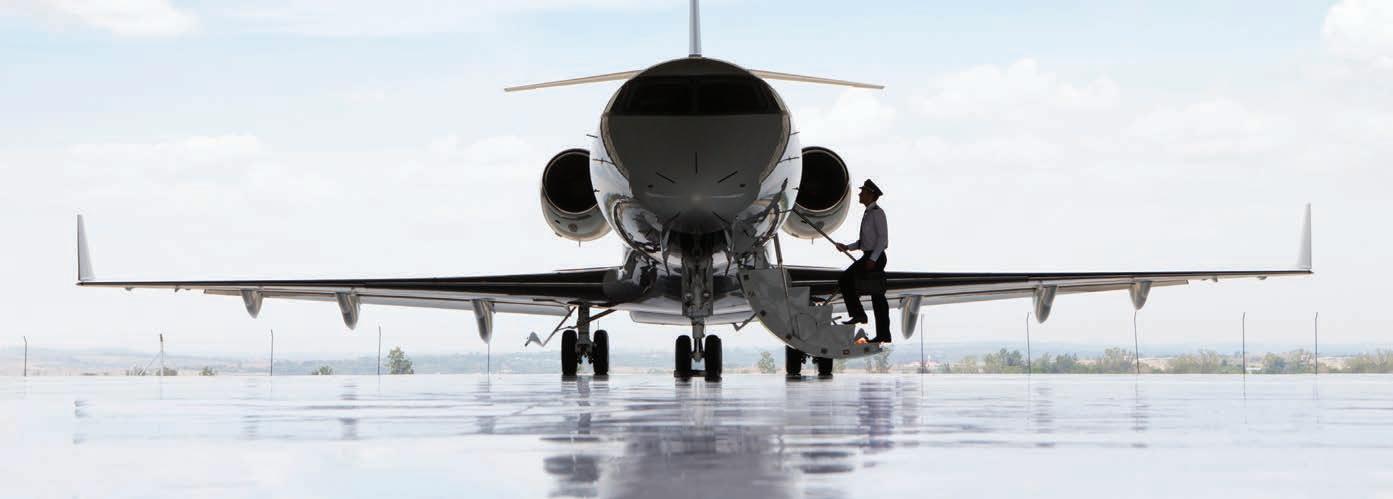
CAE Civil Aviation offers business aviation training solutions, delivering premier programs that elevate the human learning experience to provide pilots and maintenance personnel with the knowledge, skills, tools and confdence they need to ensure your business operates safely. Today we are creating ever better, smarter and more future-minded training solutions — with our broad and more digitally-immersive offering, through the world’s most expansive training facility network, and via business aviation training joint ventures that seed new growth and opportunities, both regional and global.
Tools and expertise ensuring safer fight and greater confdence.
CIVIL AVIATION
www.cae.com
Lufthansa Technik set for ACJ320 interior job
by Kerry Lynch
Lufthansa Technik landed a contract from an unnamed private customer to install a VIP interior on a new Airbus ACJ320neo. The German completions and MRO specialist antici pates that the ACJ will arrive at its facility in Hamburg in late 2023 with interior work to be completed in the first half of 2024.
Conceptualized by Lufthansa Technik in concert with the customer, the design is flexible so that it can accommodate an owner traveling with a family or a travel group charter with up to 19 passengers. This is reflected in the choice of luxurious but durable materials. At the same time, the cabin is designed within narrow weight limits to ensure that full range can be achieved with four auxiliary fuel tanks and Pratt & Whitney PW1100 geared turbo fans, the company said.
Lufthansa Technik described the layout as linear but with privacy in mind—from an open

grand entrance behind the flight deck to lounge and office areas and an aft master bedroom.

Planned features include a cabin air humid ification system and an in-flight entertainment and communications system that focuses on passengers’ personal devices and only a few large screens. Lufthansa Technik said this will be similar to a smart home with the ability to transfer personal content to built-in displays at any time. Some of the displays will be retractable.
“With its flexible interior and a top-notch entertainment system, the aircraft will set completely new standards for narrowbody VIP
With seating for up to 19 passengers, the interior on a Lufthansa Technik customer’s new Airbus ACJ320neo will feature a grand entrance, offices, and a master bedroom in the aft cabin. Other features will include a cabin humidification system, as well as in-flight entertainment and communications.
cabins,” said Michael von Puttkamer, v-p of special aircraft services. “But what pleases me even more is that we were able to convince the customer not only with our design, engineer ing, and cabin completion expertise, but with a complete package of tailor-made services.”
In addition to the interior installation, the contract calls for Lufthansa Technik to pro vide an aircraft production inspection pro gram, continuing airworthiness management organization services, and aircraft mainte nance and component support initially for five years after delivery. z
Tamarack Aero targets airliners for active winglet modification
Having successfully developed a market for its active-winglet tech nology for Cessna Citation business jets, Tamarack Aerospace is pur suing modification opportunities for other aircraft types, including Beech King Air 200 and 350 turboprops and single-aisle airliners. This week at MEBAA 2022, Tamarack founder and CEO Nick Guida is meeting with airliner manufacturing organizations, air carriers, lessors, and maintenance companies to highlight the benefits of its SmartWing active winglets.
Tamarack’s active winglets improve e ciency over traditional winglets by alleviating loads encountered during maneuvering and loads caused by gusts. In the CitationJet series, the SmartWing devices have demonstrated fuel savings of as much as 30 percent with consequent range improvements. In the A320 family (A318,
A319, A320, A321), Tamarack projects a fuel burn reduction of 10 to 15 percent, which is two to three times more than the improved e ciency of traditional winglets.
With the increased aspect ratio provided by the winglets, the modified airplane can climb to more e cient altitudes much faster, thus being able to burn less fuel earlier in the flight profile. The active winglets also improve takeo and landing performance, especially in hot-and-high conditions, and moderate the e ects of turbulence in cruise flight.
The improved e ciency makes the Tamarack winglets a useful tool in meeting sustainability targets, according to Guida.
The A320 winglet program “is really gelling,” he said. “This mar ket is huge,” referring to the 7,400 in-service A320s. M.T.
6 MEBAA Convention News • December 7, 2022 • ainonline.com
READY FOR ANYTHING
We train you to stay sharp, fine tune, and always be prepared. This empowers you with unwavering calmness and composure needed for all situations, from the everyday to the unusual. For this reason, FSI training is reserved for the sky’s most elite.
FSI. Nothing short of excellence. Call +1.201.584.8262 today or visit FlightSafety.com
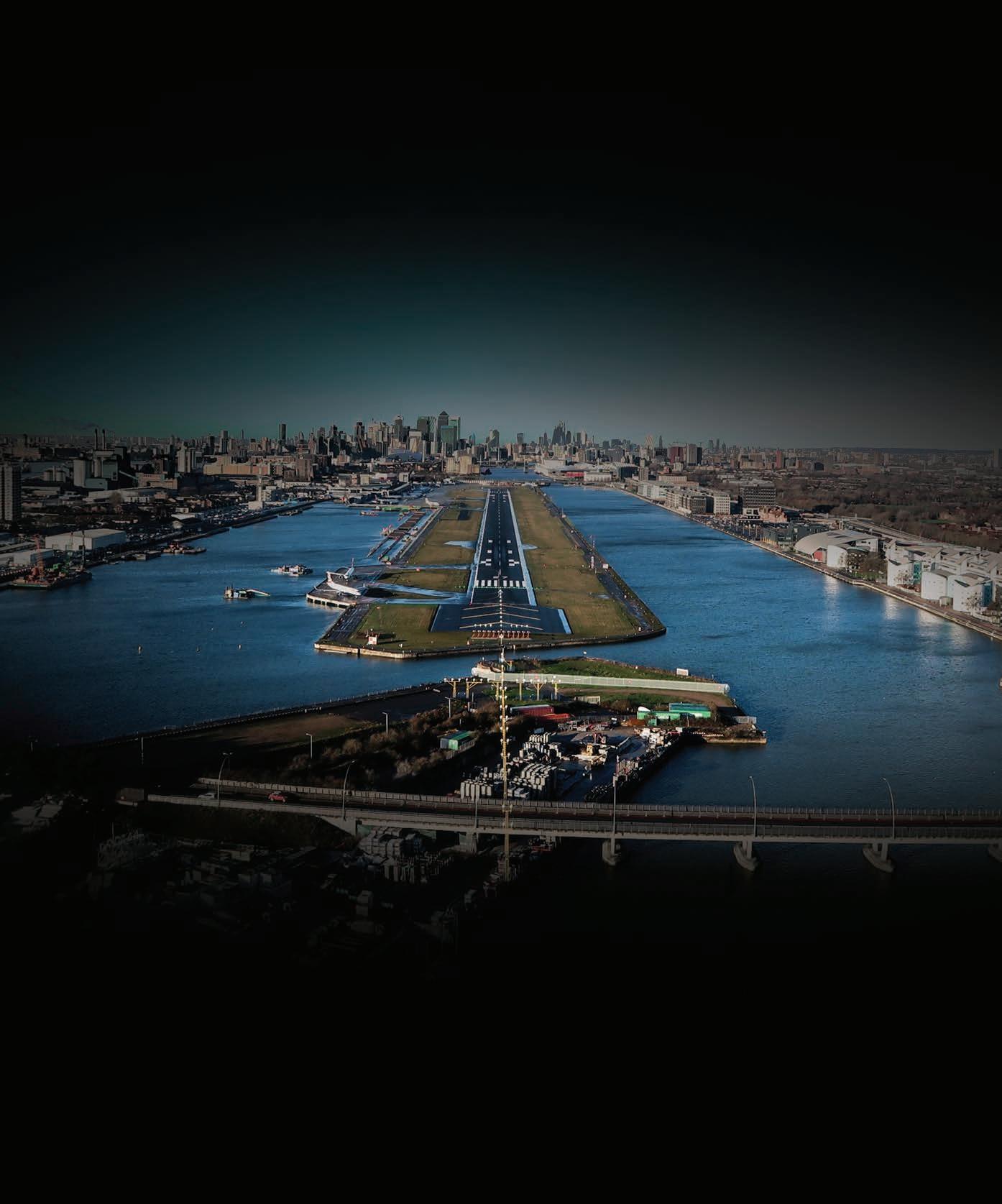
Tupan’s turbofan VTOL sidesteps battery limits
by Matt Thurber
Battery energy density is still a problem for designers who want to create electric aerial vehicles that can carry a decent payload for a useful distance, but the team at Tupan Aircraft believes it has come up with a reasonable solu tion. Tupan’s family of high-speed, vertical take off and landing (HSVTOL) drones combines electric propulsion with tiny jet-A fueled turbine engines to deliver speed, payload capacity, and redundancy in a compact and capable package.
Tupan is a new company founded by a group of Brazilian engineers with years of experience in propulsion system design, flight testing, aerodynamics, and autonomous flight. The company, based in Jacarei near São Paulo, is working with Turbomachine in São José dos Campos on development of the small tur bine engines that are key to the design of the Tupan-1000, -2000, and -3000 vehicles.
Tupan CEO Alberto Pereira founded Tur bomachine to develop a small stationary
turbogenerator for Petrobas then co-devel oped a 1 MW turbine engine then the TJ1000 turbojet engine for the Brazilian Army’s MTC300 cruise missile.
Weighing just 16 kg (35 pounds), Tupan’s turbofan engine will deliver 180 kg of thrust with a bypass ratio of 2.5:1. With low noise levels an important goal, the engine features an axial fan, centrifugal compressor, and twostage turbine—all Fadec controlled.
The Tupan aircraft is configured with four turbine engines on short wings at each corner of a flattish fuselage. Each engine can rotate to vertical or horizontal positions. Jet-A is stored in tanks in the fuselage. The largest Tupan will be able to carry up to 600 kg and fly at 850 km/h (528 mph) and have a maximum range of 1,200 km (746 miles). “We’re trying to overcome the challenges of high-speed VTOL flight,” Pereira said.
The carbon-fiber fuselage also contains bat teries for four electric motor/ducted fan propul sion units that provide vertical lift to supplement
the turbofan engines. The design will allow for a safe landing using electric power in case of failure of all four engines, according to Pereira. The benefit of having both types of powerplant is that the electric motors respond much faster than turbofans to power demands so the com bination is more flexible for certain maneuvers.
In addition to battery power for the electric propulsion, the turbine engines will drive generators to keep the battery system topped up. Each engine can feed one motor and the bat teries that serve it, but not all motors at once.
So far Tupan has flown an electrically powered radio-control model—the Tupan-RC 300—and is building a five-meter version. A mockup of the RC 300 is located at the Tupan exhibit (Stand 875). The RC 300 can carry a 2.5-kg payload at up to 150 km/h, while the Tupan-1000 will carry 140 kg; 280 kg for the Tupan-2000; and 600 kg for the Tupan-3000.
Although the Tupan aircraft is designed to carry cargo and for other unmanned applications— including firefighting, agricultural spraying, and military—the company plans on eventually devel oping passenger-carrying vehicles.
The design is somewhat modular, in that the turbofan engines could be swapped with elec tric propulsors for applications where the tur bine engines aren’t needed. An example of this might be for agricultural spraying, where shortdistance, heavy-payload flights are the norm. z
Charter operator Alpha Star selects UAS as preferred partner
Saudi government and VIP private charter operator Alpha Star has selected global trip support solutions provider UAS International Trip Support (UAS; Stand 125) as a preferred partner
“Under the strategy partnership, UAS will ensure Alpha Star receives priority international trip planning, handling, and pricing at all global destinations and take care of its fleet of 19 aircraft,” UAS said. According to Alpha Star’s website, its fleet includes Airbus, Gulfstream, Hawker, and ATR models.
Based in Riyadh, Alpha Star operates domestic and international scheduled and charter services, as well as turnkey solutions in air craft management, air ambulance, and airport management.
“Alpha Star’s attention to detail, commitment to quality, and unri valed optimization match our own,” said UAS co-owner, co-founder, and CEO Omar Hosari. “We are delighted to be working with them and this will undoubtedly be beneficial for both our organizations.”
“It is a proud moment for Alpha Star to collaborate with UAS, a regional business partner in the Middle East. This will enable us to perfect our flight planning with peace of mind that we can solicit
industry-trusted support services through UAS to carry out our opera tions to sustain our VIP customers’ satisfaction and trust,” said Alpha Star CEO Abdulnasser Alkheraif. P.S.-S.
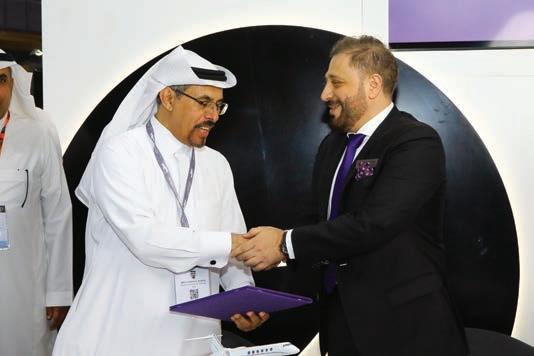
8 MEBAA Convention News • December 7, 2022 • ainonline.com
L-R: Alpha Star CEO Abdulnasser Alkheraif and UAS CEO Omar Hosari.
DAVID M c INTOSH
TITAN OF THE SKIES



















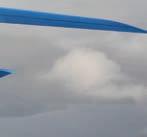










Outpace all others in the Gulfstream G700 ™—an aircraft built for life at the forefront. Enjoy the most spacious cabin in the industry, high-thrust Rolls-Royce engines and the award-winning Symmetry

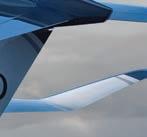


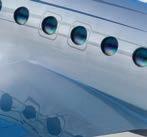




Flight Deck ™ while you rewrite the record books.


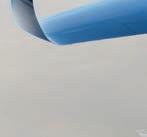









Cryptocurrency comes to the charter market
by James Wynbrandt
Its reputation may be tarnished in the financial and investment worlds, but cryptocurrency remains well-suited for charter transactions, according to a legion of boosters, as the digital coins’ quick, low-fee transfers and blockchain traceability make it ideal for such payments.
Many of these advocates note that despite charter’s “ready when you are” ethos, airplanes don’t move until operators get paid. And crypto transactions can be the best solution for trans ferring tens or hundreds of thousands of dollars after banking hours or avoiding high bank trans fer or credit card fees.
The demand is reportedly driven by a younger, crypto-savvy clientele and facili tated by payment processors that support the transactions.

“A growing number of individuals are hold ing cryptocurrencies and are willing to spend it, and they are ignored by many [charter] companies,” said Simona Moosar, business development manager at Ecommpay (Stand 376), a European e-payment processor that handles such payments for some two dozen charter firms among its clients. The biggest advantage for providers accepting crypto payments for charter, according to Moo sar: “You can actually attract a completely new clientele.”
Recent data indicates between 23.3 million and 27 million Americans own Bitcoin, the first and still dominant cryptocurrency, but data on the extent of its and other cryptocurrencies’ use for charter payments is sparse. This is because payment processors don’t make the information public, while some providers cite only rough uptake percentages. But growth reportedly continues, despite this spring’s dramatic collapse of cryptocur rency values.
“We are aware of the skepticism toward buying crypto,” said Mauro De Rosa, CEO of Ita ly’s Fast Private Jet, which claims the currency accounts for 30 percent of its business. “But paying with crypto is another story.”
At the time of the currency crash, Eymeric Segard, CEO of Switzerland’s crypto-friendly
LunaJets, wrote in the company’s EBACE newsletter, “The crypto wealth effect may disappear as fast as it stormed our industry.”
But his doubts have since subsided: “We have seen no effect on CRY[coin]-paid charter fol lowing the recent loss of value of CRY,” Segard recently told AIN. Some of his customers, he noted, “could still be making a profit when spending [cryptocurrency].”
Crypto transactions first came to air char ter in 2014, five years after the digital cur rency’s introduction. That’s when UK-based retail booking platform PrivateFly, now part of Directional Aviation’s OneSky portfolio, enabled charter payments in Bitcoin.
Fee-wise, cryptocurrency transfers typi cally cost about 1 percent of the amount transferred versus credit card fees that can range from about 3 to 6 percent. Bank wire transfer fees vary, and transfers can take several hours or business days when sent internationally.
As for transacting with a currency subject to dramatic volatility, customers can typically transfer and send the requisite amount of cryp tocurrency from their digital wallets in 20 to 30 minutes. Processors say it arrives in the fiat currency dictated by the charter contract, eliminating any devaluation risk to the providers.
Meanwhile, the long-term appetite for crypto charter payments remains unclear. At LunaJets, the payments currently “account for less than 10 percent of our revenue, but [they’re] growing every quarter,” said Segard. Conversely, while first adopter PrivateFly previously reported crypto transactions accounted for up to 20 percent of book ings, “payments made in this way currently account for less than 10 percent of transac tions,” PrivateFly European managing direc tor Marine Eugène told AIN z
CAE opens new Gulfstream flight simulator training locations in U.S. and Singapore
CAE (Stand 175) is ramping up its Gulfstream training in facilities at Las Vegas; Savannah, Georgia; and Singapore.
CAE Las Vegas began training G650 customers in a full-flight simulator (FFS) on October 14. Other training operations ramping up in Las Vegas include FFS training in the G550 followed by the Bom bardier Global 7500, Embraer ERJ-145, and Phenom 300 by year-end and a Gulf stream IV by spring 2023.
Maintenance training for the Gulfstream G650, G600, and G500 has begun at Savannah Technical College facilities, while construction continues on the new CAE Savannah campus. CAE Savannah will open for training in mid-2023 and feature
four FFSs, including those for the G280.
Meanwhile, a G650 FFS will begin hosting students at CAE Singapore in November.
CAE employs more than 13,000 in 200 sites across 40 countries, training pilots, technicians, defense and security forces, and healthcare workers. M.H.

10 MEBAA Convention News • December 7, 2022 • ainonline.com

THE FUTURE OF ADVANCED AIR MOBILITY NEWS, DATA AND ANALYSIS COVERING ALL ASPECTS OF THE ADVANCED AIR MOBILITY MARKET INCLUDING INVESTMENTS, INFRASTRUCTURE, AIRCRAFT MANUFACTURERS, SUPPLIERS AND MORE! FutureFlight.aero Sign up for our free newsleter.
Krimson Aviation plans new FBO in Northern Africa
by Peter Shaw-Smith
Ethiopian trip support firm Krimson Aviation plans to set up an FBO, likely in East Africa, as it completes an investment round before the end of the year. The company intends to break ground on this new facility in January.
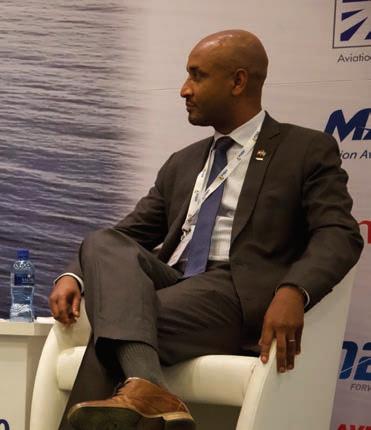
“It won’t be in Ethiopia,” Krimson founder and CEO Dawit Lemma told AIN. “We’re signing documents, and we’re investing. It takes six months to a year to build. In January, we’re hoping to finish the process of identifying a location, going ahead, and then starting the regulatory procedures.”
Ethiopia’s civil war has dragged on for two years, although hopes rose with the November 2 signing of a truce between the two sides in Pretoria, South Africa. “I’d have to say that the last year has been a roller coaster, a hurricane, and a tornado, all in one,” he said. “Good and bad, but progression, too.”
And the emergence of the Ukraine crisis hot on the heels of Covid was causing huge issues. “Inflation is a major problem,” he said. “Fuel prices are a major problem. Inter estingly enough, airplanes are still flying, but we definitely saw a dip in requests from April. Of course, in the natural summer months, there’s always a dip. As of September, we’re back to full speed ahead in terms of number of operations.
“To be perfectly honest, for us, for our business, conflict—and I hate to say this— generates business for Krimson. It increases the number of military operations—military flights, a lot of military cargo flights, delivery of goods—the humanitarian situation drives the scope of humanitarian operations.”
Meanwhile, Lemma said business aviation was changing in Africa as the continent shook off the Covid pandemic. “It’s actually doing well,” he said. “Africa is resilient. We just keep getting hit with one crisis after another and we just take it, to be honest.”
He regards the business today as a panAfrican, rather than simply Ethiopian, concern. “We’re definitely pan-African,” he said. “We have crossed a threshold where we actually have an equal number of operations outside of Ethiopia, compared to inside the country.”
He said the company’s focus today is the Horn of Africa. “We do get ad hoc requests for random countries like Gabon or Liberia,” he said. “Our core market is the Horn of Africa.” Krimson’s competencies and market strength lie in Eritrea, Ethiopia, Somalia, Dji bouti, South Sudan, and part of Sudan. It also has agents on the ground in Mogadishu, Har geisa, Juba, and Asmara. “There’s just a lot of growth happening,” he said. “Regardless of the conflict in Ethiopia, this region of Africa is probably the least developed compared to other areas. Development is exponential.” z
Krimson
FBO.
IBAC makes governing board appointments
The International Business Aviation Coun cil (IBAC) has confirmed the latest appoint ments to its governing board of executive directors during a recent board meeting in Orlando, Florida. Ali Alnaqbi, founder and chairman of the Middle East and North Africa Business Aviation Association, will serve as chairman of the IBAC governing board for a second term; Juergen Wiese,
chairman of the European Business Avia tion Association, will serve for a second term as vice chairman; and Cynthia De Oliveira, managing operations director at Lider Aviação and member of the Brazil ian Association of General Aviation, will assume the role as treasurer from Sudhir Nayak of the Business Aircraft Operators Association of India.
“We continue IBAC governance with board executives that represent the global business aviation industry,” said IBAC direc tor general Kurt Edwards. “I appreciate Ali Alnaqbi and Juergen Wiese for continuing their leadership roles on the governing board. Many thanks to Sudhir Nayak for his contributions over the last several years and his dedication to business aviation. IBAC welcomes Cynthia De Oliveira as the incoming treasurer and looks forward to working with her and the entire board over the next three-year term to meet the needs of a vibrant and growing industry.”
The International Business Aviation Council appointed MEBAA founder and chairman Ali Alnaqbi to its governing board of executive directors for a second term.
IBAC was established in 1981 and serves as an international voice for the business avi ation community. Its governing board includes representatives from each of its 15 member associations across the globe. K.W
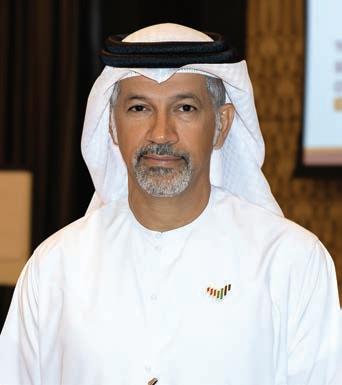
12 MEBAA Convention News • December 7, 2022 • ainonline.com
Aviation CEO Dawit Lemma is preparing for business aviation growth opportunities in East Africa, including plans for a new






































Celebrate! heliexpo.com REGISTRATION IS OPEN! 75 5YEARS 1948–2023 HAI HELI-EXPO March 6–9 Exhibits Open March 7–9 SCAN AND REGISTER TODAY! Space available. Apply Now!
JSSI sees growing bizjet market in Middle East
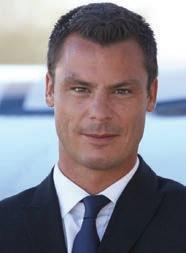 by Peter Shaw-Smith
by Peter Shaw-Smith
Jet Support Services Inc. (JSSI, Stand 250) believes the Middle East is an important region and a growing market as it supports increased demand for aircraft ownership and charter, officials in the region told AIN.
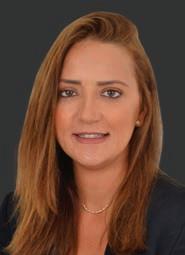
“This regional growth [mir rors] what we’re seeing globally, as the business aviation industry benefits from waves of first-time users and buyers,” said Pascale Barhouch, the company’s direc tor of business development for the Middle East. “We saw this trend emerge during Covid-19 and the phenomenon has con tinued, spurred on by the ongo ing struggles of commercial aviation. We anticipate this growth will continue into 2023.”
JSSI’s OEM-agnostic business model is the same worldwide, with dedicated local support in each region. “Across our prod ucts and services, we support approximately 20 percent of the global business aviation fleet, have visibility into more than 5,000 aircraft on JSSI programs and software, and oversee in excess of 10,000 maintenance events annually,” she said.
“This means that, regardless of aircraft type or operation size, we can bring custom ers an unmatched combination of objective information, dedicated maintenance sup port, and technical experience, combined with a neutral vantage point and global scale that others simply can’t match,” according to Barhouch.
Full Suite
From maintenance programs to maintenance software and independent technical advice, JSSI offers a full suite of products and services to drive cost savings and provide impartial and transparent handling of business aircraft maintenance events.
“As an all-OEM aircraft parts provider, we are also able to support customers with strategically located parts across virtually all makes and models of business aircraft. It means
customers are increasingly seeing JSSI as their maintenance partner, not just another thirdparty supplier,” she said.
The MRO build-out at Dubai Al Maktoum International Airport (OMDW), particularly in the former Aviation District now known as the Mohammed bin Rashid Aerospace Hub (MBRAH), is gaining momen tum, according to Fabrice Roger, JSSI’s senior v-p of business development for Europe, Mid dle East, Africa, and Asia-Pacific. “There is no doubt that there is a need to enhance maintenance infrastructure in the UAE. And with Dubai’s central location, the developments at the MBRAH are clearly positive for business aviation,” he said.
“As more aircraft enter the region, it is inevitable that the demand for MRO services will also increase accordingly. JSSI is well positioned to help those MRO businesses grow not only through the maintenance requirements of our customers, but also with maintenance soft ware to provide full visibility into their operation and help them build more efficient businesses,” Roger noted.
Today, JSSI claims to work with the widest MRO network in the industry to ensure avail ability on behalf of customers. He said it will continue to pro actively work with these new MROs as it anticipates market trends and supply-chain constraints to help its customers keep a step ahead of competitors.
While concurring that Saudi Arabia has recently experienced a lull in business avia tion flying, Roger said JSSI still found plenty of activity in the kingdom. “Despite a slowdown in business aviation flying in Saudi Arabia, we are still seeing requests for maintenance support and our customers are still seeing high levels of demand,” he said.
As to the prevalence of new versus
preowned aircraft in the Middle East market today, and the implications for engine man agement, Roger said new-production aircraft remained a strong feature of the market.
With new deliveries continuing in the Middle East, predominantly from pre-exist ing orders, he has not noticed a slowdown in this aircraft market. However, a signif icant increase in demand for the limited inventory of preowned aircraft has been observed in the region, aligning with wider global trends.
Growing Demand
“As the regional fleet grows, demand for manag ing any type of maintenance event and sourc ing the required materials will also increase. With visibility into maintenance requirements through our maintenance software, we can work with customers on planning these events in advance, alleviating the last-minute scram ble for scheduled events,” he said.
“Ongoing supply chain constraints mean aircraft owners will need an independent advocate working on their behalf now more than ever to minimize downtime, improve turn times, and maximize value and effi ciency throughout each maintenance event,” Roger noted. “We are in the process of adding another strategically located technical advisor in Dubai to ensure our customers in the region get the support when and where they need it.”
Roger said current infrastruc ture in the region was unlikely to grow at the pace required to meet the trajectory of aircraft com ing into the Middle East. With major global events such as the now-underway 2022 FIFA World Cup in Qatar, the region will see a rapid rise in business aviation tra ffi c, requiring a strong pres ence of maintenance support to sustain it.
“This makes JSSI an increasingly vital part ner to customers operating in the Middle East,” he said.
“Our customers can not only benefit from JSSI’s scale, but also from our industry knowledge, anticipation of market trends, and enhanced MRO availability. We will con tinue to work across product and industry siloes to ensure our customers are always empowered to make informed decisions and perform maintenance on their terms,” Roger concluded.
14 MEBAA Convention News • December 7, 2022 • ainonline.com
z
Pascale Barhouch, Middle East director of business development
Fabrice Roger, svp business development EMEA and Asia-Pacific
A cabin mockup of Supernal’s planned five-seat eVTOL aircraft.

Supernal eVTOL to feature Honeywell Anthem avionics
by Charles Alcock
Honeywell will provide its Anthem integrated avionics suite for Supernal’s five-seat eVTOL.
On October 17, the advanced air mobility division of Korean car maker Hyundai confirmed it will use the always-on cloud-based avionics suite that Honeywell introduced in 2021 as a versatile platform that can be adapted for multiple aircraft types.
Supernal expects the Anthem system to deliver the connectivity it needs to inte grate an array of complex technology it will be using for the SA-1 eVTOL vehicle that it wants to get into commercial service in 2028. Anthem will also underpin the company’s efforts to achieve high degrees of autonomy in the way the aircraft is operated.
The SA-1 is the third application for the Anthem suite, which has already been selected by rival eVTOL aircraft developers Lilium and Vertical Aerospace. Honeywell said the system can be readily adapted to support a wide variety of business aircraft and airliners.
Anthem will allow pilots to share data via the internet and also to access software while online inflight. Before departure, pilots can plan flights and configure the avionics suite offline by accessing the Honeywell Forge platform on any smart device. A secure server stores information about the aircraft, and the flight crew can access this remotely.
In the future, the Anthem system will
enable so-called simplified vehicle opera tions that will reduce the level of experience required for eVTOL aircraft pilots. Honeywell (Stand 951) said this transition will be a first step toward fully autonomous operations in which eVTOL operators would manage their aircraft remotely.
“Supernal is leveraging synergies between [the] automotive [industry’s] high-rate man ufacturing capabilities and aerospace’s high certification standards to build the foun dation for everyday air vehicle transporta tion,” said Jaiwon Shin, CEO of Supernal and president of Hyundai Motor Group. “We are pleased to work with aerospace leader Honeywell to mature advanced air mobility avionics systems and certify our eVTOL aircraft to the highest commercial aviation safety standards.”
Last year, Honeywell set up its new Urban Air Mobility and Unmanned Aerial Systems business unit to focus on the needs of new air craft developers. Stéphane Fymat, the new divi sion’s v-p and general manager, said Anthem will “change the way aircraft are piloted.”
The company said it expects to start the FAA’s type certification process for the SA-1 in 2024. And earlier this year, it announced plans to introduce a hydrogen-powered eSTOL aircraft.
Initially, the SA-1 will be flown by a pilot and will seat four passengers, although the company plans to eventually switch over to autonomous flights with a six-passenger ver sion of the vehicle. It will be designed to cruise at up to 180 mph and an altitude of 1,000 to 2,000 feet, with a range of about 60 miles on a single charge, with a recharge expected to take no more than five to seven minutes. z
Honeywell’s TFE731 turbofan engine turns 50
Honeywell Aerospace (Stand 951) is marking a major milestone with its first purpose-built business jet engine, the TFE731, which turned 50 years old this year. The turbofan engine, 13,000 of which have been pro duced to date, continues to power jet types such as the Dassault Falcon 900, Bombardier Learjet 70/75, and Gulfstream G150.
According to Honeywell, 9,400 of the engines remain in service today and in total have accumulated 108 million flight hours. The engine was designed to meet the specific needs of business jets while other engines from the era were adapted from existing military jet engines. Honeywell predecessor Garrett (and later AlliedSignal) developed the TFE731 in the late 1960s to provide the nascent business jet market
with an engine that would fly coast-to-coast without refueling and that was reliable. The engine also lead to the development of Honeywell’s HTF7000 family that powers some current-production super-midsize jets. Besides being the company’s first tur bofan, the TFE731 also was the first geared turbofan engine with a dual-spool design to improve fuel e ciency and range. Dassault and Learjet were the engine’s launch cus tomers, later to be followed by other OEMs such as Cessna, Lockheed, Israel Aero space Industries, and Raytheon Aircraft/ Hawker Beechcraft. Later adopted in mili tary training aircraft such as the CASA 101 and AIDC AT-3, the TFE731 has received 34 type certifications and was produced in 80 configurations. J.S.
ainonline.com • December 7, 2022 • MEBAA Convention News 15
M c INTOSH
DAVID
Jetcraft: used market to normalize after 2021
by Kerry Lynch
Aircraft broker Jetcraft is predicting that preowned business jet transactions will dip slightly this year and then rise at a 3.6 percent compound annual rate until yearend 2026, according to its latest Five-Year Pre-Owned Business Jet Market Forecast, released in September.

“This year’s report predicts that, after stabilizing in the wake of a post-Covid surge, preowned transactions should maintain their new higher base and growth rates, reaching 10,921 transac tions valued at $66.6 [billion] over the forecast period,” said Jetcraft CEO Chad Anderson.
Last year’s preowned jet transactions reached a record value of $14.5 billion, a nearly 40 percent increase from 2020, primarily driven by midsize and large-cabin jet purchases, the company said. Despite an equally strong perfor mance earlier this year, Jetcraft expects the market to soften,
with normal depreciation levels resuming in 2023.
Jahid Fazal-Karim, owner and chairman of Jetcraft, said in the report that the market has not yet returned to pre-pandemic norms and the industry is still “in an opportunistic position.” However, it is trending more toward “nor mality,” Fazal-Karim added.
“When compared to 2020, it might feel as though prices are rising at an unstable rate,” he said. “Our data, however, indicates this is a rational market, with value
growth expected to return to pre-pandemic levels.”
Unlike the time between 2004 and 2007 when the preowned market experienced 50 percent average price increases, the current period has pricing that reflects short-term world events and remains “far more rational” with average prices returning to pre-pandemic levels, according to Jetcraft.
North America has led growth in demand for preowned aircraft, with its market share growing
from 53 percent in 2010 to 73 percent in 2021. Even so, Jetcraft identified international growth areas in the report, noting that the ultra-high-net-worth popula tion in Asia-Pacific—a region that prefers large-cabin jets—is set to increase 33 percent over the next five years.
The study reports that the share of preowned jet buyers under age 45 has risen 20 per cent since 2017 and notes that the younger age group is trend ing toward larger aircraft with an average transaction price of $25 million. This is 31 percent more than the over-45 demographic.
“Shifts in buyer behavior con tinue to fuel this upward tra jectory with more and younger first-time buyers entering the market, greater demand for larger jets, and a growing ultrahigh-net-worth population. And we’re now entering a postpandemic business cycle from a new, higher starting point,” FazalKarim added.
By model segment, preowned transactions for large aircraft are expected to dip from 419 aircraft in 2021 to 368 this year. However, they will grow steadily each year thereafter, exceeding 2021 levels by 2024, and reach ing 483 by 2026.
Midsize aircraft transactions will experience a similar yearover-year slide, from 573 in 2021 to 507 this year, but grow at a slower rate, exceeding 2021 lev els in 2026. Light aircraft, how ever, are forecast for the biggest drop from 1,427 preowned trans actions last year to 1,119 this year. They are not expected to return to 2021 levels over the forecast period, ebbing upward to 1,240 by 2026.
Market value is projected to have peaked in 2021, dipping to $13.7 billion this year and then $13 billion next year. Growth in pric ing is anticipated to be uneven and slower after that, but not to return to 2021 levels before 2027.
16 MEBAA Convention News • December 7, 2022 • ainonline.com
z
Jetcraft’s latest forecast calls for 10,921 business jet transactions worth $66.6 billion from 2022 to year-end 2026. These higher values will be driven by midsize and large-cabin jets, aircraft like this Gulfstream G280.
“This year’s report predicts that, after stabilizing in the wake of a post-Covid surge, preowned transactions should maintain their new higher base and growth rates.”
Jetcraft CEO Chad Anderson
DAVID
M c INTOSH

AIRFRAME MAINTENANCE | AVIONICS | CABIN TECHNOLOGIES | CLEANING | ENGINEERING | FLOORING | FUTURE CABIN CONCEPTS GALLEY | IFEC | IT SYSTEMS | LIGHTING | SAFETY | SANITISATION | SEATING | SUPPLY CHAIN | TEXTILES | TOOLING 01–02 March 2023 Sheikh Saeed
2 – 3 Dubai
Trade
UAE CONNECTING THE AIRLINE SUPPLY CHAIN We pre-arrange meetings for exhibitors with key airline buyers at the show. Contact us to learn more: WWW.AIME.AERO Co-located with:
Hall
World
Centre,
Citadel gears up to meet
‘hot’ refurb,
by James Wynbrandt
MRO demand
With an influx of first-time buyers and demand for upgrade projects from current owners, the market for VIP airliner refur bishment and MRO services “is hot right now, and we don’t see that tapering off anytime soon,” said Noel Christen, v-p of operations at Citadel Completions (Chalet A10) of Lake Charles, Louisiana.
“You’re seeing lots of new aircraft owners, especially in the narrowbody market, buying up the BBJs and ACJ319s,” he said. “I have three aircraft we’re doing large-scale refur bishments on right now that are for firsttime owners.”
This week at MEBAA 2022, Citadel is pre senting examples of its work and capabil ities in a multimedia display environment hosted by key executives at its chalet. “We are showcasing our talents and accentuating the incredible team that we have for putting together aircraft completions and refurbish ments,” said Christen.
The chalet has two private conference rooms for meetings and presentations, and

visitors can also take iPad-based “tours” of interiors and don Oculus 3D goggles for vir tual cabin walkthroughs. Its virtual demos are complemented by actual fine interior items on display. And, as marketing director Michelle Savoy noted, “It’s a nice space for people to come in from the sun, relax, and have some refreshments.”
Additional Citadel team members at the show this week include the company’s new UAE-based business development director Vanessa Roberts, whose 30 years of experience
in the region include positions with Presidential Flight Group and Royal Jet Group; director of MRO sales Paul Kosik; and director of IT Taylor Simpson.
Founded in 2017, Citadel is something of a newcomer to the VIP completions arena. However, the predecessor facility had long experience in aftermarket work on transport category aircraft, while the lineage of Citadel’s ownership—the Adelson and Dumont fami lies—have long ties to the Middle East. Citadel made its aviation world debut at MEBAA 2018 and exhibited at last year’s Dubai Air Show.
Based at Chennault International Airport, which has a 10,700-foot primary runway, Citadel has more than 260,000 sq ft (24,150 sq m) of hangar space, which has been busy over the past year.
“From a topline perspective, this year we did double what we did last year, and we expect even greater growth going into 2023,” Chris ten said. “We’ve had about 49 projects to date, a good mix of refurbishments and MRO.”
Indications are that the projects included the recent refurbishment of former U.S. Pres ident Donald Trump’s Boeing 757. The proj ect made news as it was viewed as a portent of potential campaign activity; reports cited the aircraft’s return-to-service test flights around Lake Charles, Louisiana—home of Citadel Completions—in the third quarter. Queried about the reports, Christen said the project was “tremendously successful,” but when asked to verify that Citadel had per formed the work on the Trump aircraft, he said, “I cannot confirm nor deny” the com pany’s involvement.

For all projects, he said, Citadel applies what it calls “dynamic project management.”
“Quality is our mainstay, and that starts at the onset with project management,” he said, involving timing and coordination of all aspects of the work, “Ensuring that every single thing we do is done with meticulous attention to detail, and everything is accountable.”
Clients are kept closely in the loop throughout the process, able to share proj ect milestones remotely through interac tive technology.
Citadel has no green completion projects in its hangar or under its belt to date, but Christen noted the company is a Boeing-authorized completion center for the 777, as well as an authorized Boeing service center, and it was recently named an Airbus authorized service Center and plans to seek Airbus authorized completion center approval. z
18 MEBAA Convention News • December 7, 2022 • ainonline.com
A VIP airliner refurbishment is the result of careful timing and coordination of all elements of the project, a process that Citadel Completions calls “dynamic project management.”
The capabilities of Citadel Completions’s talented carpenters are on prominent display in this elegant four-place table.
Bizav movements climb at SEA Prime’s Italy FBOs
 by Peter Shaw-Smith
by Peter Shaw-Smith
Milan, Italy-based SEA Prime’s FBO facilities at Linate and Malpensa airports saw a 42 per cent year-over-year increase in business aircraft movements in the first eight months. This also represents 154 and 29 percent increases from the same periods in 2020 and 2019, respectively.
“Last year, we saw more than 27,000 movements at the two airports combined and we expect to reach over 30,000 movements this year,” said SEA Prime CEO Chiara Dorigotti. The company operates these airports under its Milano Prime brand.
“January to August is looking extremely good and [we saw] a good September because of all the events happening in Milan,” Dorigotti said. “At the Formula 1 Grand Prix on September 9 to 12, reported increases in the number of race spectators over the week end—336,000, compared with 200,000 in record-year 2019— were accompanied by an increase in movements managed by SEA Prime of 54 percent compared with 2019, while 75 percent of managed air traffic was international.”
Dorigotti also expressed plea sure with the turnout at EBACE 2022. “It was well attended,” she commented. “We were happy to meet in person as we did in the U.S. in April at the NBAA Sched ulers and Dispatchers event in San Diego. This was our first business aviation-related event in some time. In fact, we were also in Dubai in November 2021 for the airshow, which attracted a lot of business aviation exhibitors.”
Milano Prime (Stand 432) claims to be an important gateway to
international and sporting events in Milan, which include soccer’s Champions and Nations Leagues and basketball’s EuroLeague.
“Even though fuel prices and economic and political uncertainties may have a potential impact, we expect to close this year with solid double-digit growth,” Dorigotti said. “We are looking very carefully at higher fuel prices and war-related uncertainty. In terms of traffic trends, in 2021 we have seen a slight change, in the sense that, versus last year, we have had more international and less domestic traffic.
“We’ve been seeing more inter continental traffic,” she contin ued. “Flights from and to North America are up 200 percent ver sus last year.”
Personnel Shortages
Regarding airport operations, a shortage of personnel has impacted business in general in Italy. Regulations on employee subsidies meant people were, for the most part, not actually laid off but frozen in furlough schemes. However, handlers have managed to get their personnel back.
“As a result, we have not seen
meaningful operational challenges,” Dorigotti remarked. “We can man age traffic well, and fuel is available. The fact that business has recov ered has not impacted numbers, but it’s impacted the mix. Domes tic flights have decreased because more people are traveling abroad due to easing restrictions on inter national travel.”
SEA Prime’s growth remains higher than Europe’s, overall. Cit ing WingX data, Dorigotti said Europe had been growing at 18 percent this year through July. “In comparison, we have been growing at 35 percent,” she noted. “Milan is still the key business aviation air port for traffic in Italy today. In July, Italy was Europe’s third-largest market. Inland represents a signifi cant share. Of course, in August, we saw a lot of traffic in holiday loca tions, like the islands or the south.”
Linate has higher traffic vol umes; Malpensa Prime has fewer flights, but bigger aircraft sizes. Malpensa is more of an inbound airport, typically for traffic from North America and the Middle East, being close to Lake Como and Lake Maggiore.
“We also see bigger aircraft around Malpensa Prime because
they have two runways that can accommodate BBJs and ACJs,” Dorigotti said. “When we designed it, we targeted a differ ent type of traffic. It’s also close to Switzerland and Lugano [Italy] and to a number of winter sports destinations in northern Italy. In Malpensa Prime, we also host a number of flights, particularly for sports teams, and music bands.”
The sole FBO operator in Milan, SEA Prime’s ownership is a public-private mix. It is held 100 percent by the commercial air port manager at Linate and Mal pensa, SEA, the second- largest commercial aviation operator in Italy. In turn, SEA is 51 per cent owned by the municipality of Milan, with the balance being held by two private equity funds.
Immediate expansion plans put infrastructure at the focus of development. SEA Prime (Stand 432) runs 10 hangars in Linate Prime and a large one at Mal pensa Prime. It is adding an 11th at Linate, a maintenance hangar consolidating and expanding the Bombardier authorized service facility managed by Directional Aviation Group’s Sirio.
Longer term, Dorigotti said, operators required a concession from the government to be eligi ble to be airport managers in Italy. Its indirect shareholder owns other Italian airports, including Naples, Olbia, and Turin. “In my view, it could be interesting to develop a network of busi ness aviation airport managers exploiting commercial and oper ational synergies,” she said.
“There is definitely organic growth potential where we are, in Milan, our focus today,” Dorigotti concluded. “However, if new opportunities materialize, and if tenders are issued, we will look at them. Our shareholders will ultimately decide growth strategy and capital allocation but we will be potentially active if opportunities arise in Italy and, potentially, abroad.” z
ainonline.com • December 7, 2022 • MEBAA Convention News 19
Sea Prime’s Hangar at Linate Airport in Milan, Italy.
Honeywell sees strong growth ahead for bizav
by Curt Epstein
Business jet operators in the Middle East and Africa plan to replace 4 percent of the installed fleet over the next five years according to the recentlyreleased results from Honeywell Aerospace’s 31st annual Global Business Aviation Outlook. Based on the result of its yearly survey of worldwide operators combined with the company’s market analysis, Honeywell predicts the busi ness aviation market could see as many as 8,500 new jet deliveries worth $274 billion over the next decade, It also calls for 700 busi ness jet deliveries this year, and a 17 percent increase next year, along with a 20 percent boost over 2022 billings.
According to the results of this year’s survey and airframer back logs, that increasing trend will continue through the next decade. “I would say the most surprising thing was the 15 percent jump
in the 10-year forecast, not just in terms of units, but also in terms of expenditures,” said Javier Jimenez Serrano, strategy and market research manager at Honeywell Aerospace (Stand 951). Each year the company surveys a pool of respondents that is rep resentative of the world fleet in terms of where they operate and what type of aircraft, what size category, and also what type of operator, whether it is charter or VIP/corporate.
New jet deliveries and expen ditures are projected to grow at a 2 percent annual average rate, keeping pace with worldwide economic growth. The forecast extrapolates direct results from the annual survey of operators chosen from the global pool based on market segment, geographic area, and type of aircraft used for the first half of the 10-year fore cast window, and then distills econometric data for the remain ing five years.
Operator five-year purchase plans are up by three percent age points compared with last year’s survey results, reaching pre-Covid 2019 levels and equal ing a 17 percent replacement of the current fleet. “Demand for new business jets is as high as we’ve seen since 2015, and we expect high levels of demand and expenditures for new aircraft for several more years,” said Heath Patrick, president of Honeywell Aerospace’s Americas aftermar ket division.
Based on the results of the survey, operators are expressing strong optimism in 2022, with an overwhelming 96 percent believing they will fly as much or more next year. “The busi ness aviation industry is greatly benefitting from a wave of firsttime users and buyers due in part to changing habits brought on by the Covid-19 pandemic,” explained Patrick. “The busi ness aviation sector is expected to recover to 2019 delivery and expenditure levels by 2023, which is much sooner than pre viously expected.”
Those first-time users helped buoy the industry at times this year to flight utilization rates not seen since 2007, the high water mark for business avia tion. In response to industry concerns about whether those
new customers will remain, 74 percent of new users surveyed said they expect to keep the same level of flying in 2023 as they did in 2022.
Over the next five years, Hon eywell expects the large and long-range jet categories will account for 70 percent of all new jet expenditures and will total 38 percent of all unit purchases, compared with 26 percent for the medium cabin and 36 percent for the light jet categories.

“That is driven by the clean sheet new o ff erings entering service there: the [Gulfstream] G700 and G800, [Dassault] Falcon 10x, and the recently announced [Bombardier] Global 8000,” Serrano told AIN. “We also see growth in the large-cabin category that is cur rently where the Challenger 650 and Falcon 2000 are. It’s an area that has been neglected frankly, those designs are from the 1990s. We saw that area of the market starting to grow with the G400, but we expect that there will be more clean sheet refreshes in that area, and the market will support them.”
Among its survey questions, Honeywell also queried respon dents about their sustainability efforts, with half indicating they are implementing at least one method to reduce their carbon footprint, a rate 30 percent higher than last year. Among the meth ods cited, the use of sustainable aviation fuel (SAF) ranked third behind “fewer or slower pri vate jet trips,” and “increasing passenger capacity,” with many operators noting challenges in SAF availability. Yet, 37 percent of respondents say they believe SAF will be the most common way for them to operate in a more envi ronmentally friendly manner in the future.
Based on the results of this year’s survey, more than 60 per cent of operators plan to either adopt or increase their sustain ability efforts. z
20 MEBAA Convention News • December 7, 2022 • ainonline.com
Honeywell’s 31st Global Business Aviation Outlook projects significant growth in the valuation and deliveries of long-range, large-cabin business jets over the next decade.

PILOT REPORT
Flying Dassault’s Falcon 6X
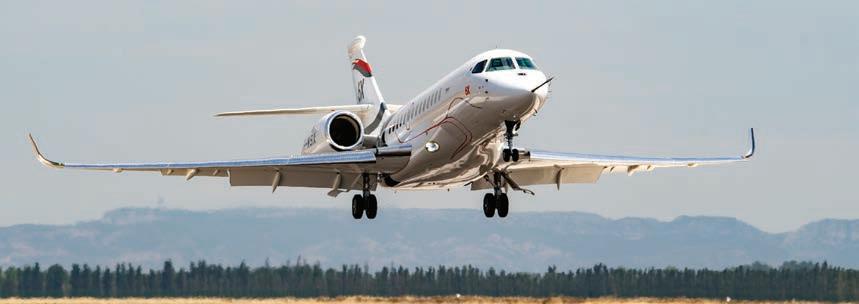 by Matt Thurber
by Matt Thurber
Flight test activity on the Falcon 6X fleet has reached the stage where it’s now a matter of prov ing the jet’s reliability and assur ing the cabin features meet the demanding requirements of a $57 million jet.
In the meantime, the 6X has matured to the point where Das sault invited AIN to sample its flying qualities and performance ahead of certification and entry into service early next year. Per the usual process, I traveled to Dassault’s Istres Flight Test Cen ter near Marseille, France, to fly the 6X.
The first step was a briefing with test pilots Bruno Ferry and Tom Valette, and flight test engineer Flora Corsia at Istres. We would be flying the first 6X, serial number 1, the same air plane which Ferry and Valette flew on March 10, 2021, marking the beginning of the 6X flight test program. As the original proto type, this 6X is not equipped with a production interior and carries a cabin full of test equipment including water tanks used to quickly adjust weight and balance.
In preparation for that first flight, Ferry, Valette, and other Dassault test pilots spent time learning about the new jet’s
systems and operating characteris tics in the systems integration test station (SITS) simulator, which is located at Istres. This also was my introduction to the 6X. The SITS doesn’t exactly replicate the 6X as it isn’t a full-motion simulator and it doesn’t have flight control actuators, which the bench test facility at Dassault’s headquarters in Paris does. But the SITS does duplicate the 6X’s systems and avionics, which is now the EASy IV suite based on Honeywell Primus Epic avionics.
Each new Falcon jet improves upon the last, and the 6X is no exception. Now the largest Falcon with the widest and tallest cabin of any purpose-built business jet, the 6X incorporates unique design features that should appeal to owner and pilot alike.

Originally launched as the 5X, the 6X came about after the 5X
was canceled because of insur mountable problems during the development of the 5X’s Safran Silvercrest engine. A fuselage stretch matched the airframe to larger engines—Pratt & Whitney PW812Ds—and the result was serendipitous, a longer-range, wide- and large-cabin jet that probably was a better fit for the market shift toward ultralong-range and large-cabin busi ness jets.
With years of experience designing and manufacturing digital flight control systems in-house, Dassault engineers have maximum flexibility when it comes to expanding its franchise in the large-cabin market. Das sault’s fighter jets were its first aircraft to feature fly-by-wire flight controls, then the Falcon 7X business jet was so equipped, entering service in 2007. The 7X
and 8X proved that it is possible to make large Falcon business jets with the pleasant handling characteristics of their conven tionally controlled predecessors. The 6X continues that philoso phy, but with full digital control of all flight control surfaces. This includes integration of flaperons, giving designers even broader options for fine-tuning the flight controls to optimize perfor mance and handling.
Systems Changes
Dassault aims to make it easy for pilots to transition between models, and the 6X has just two operating techniques that are different from the 8X, according to Ferry. “For us,” he explained, “it’s important that the family of Fal cons, especially for normal procedures, has to be the same.”
But that doesn’t mean that Dassault engineers didn’t take the opportunity when designing the 6X to make it even easier to operate compared to the 8X.
Preparing for engine start is much faster with a redesigned overhead control panel (OCP) that has many fewer buttons and a dark-cockpit philosophy. A dark button now signifies what Ferry said is called “dark auto,” and this means that the system could be on or off. What each button indicates, according to Ferry, is “not the sta tus of the system, it is the status of the command. In the procedures, when you have to check a specific position of a button, we say: ‘dark auto’ because the system chooses between off or on; and a lighted [button] is on or off depending on the status of the command.”
Bringing the 6X to life starts with one switch moved to the “on” position, then the aircraft runs through an automatic systems initialization process. Once that is done, the APU is started so bleeds can be switched on for engine start. Another 6X change is that both engines are started with one knob; just move the power levers
22 MEBAA Convention News • December 7, 2022 • ainonline.com
The Falcon 6X cabin is 6.5 feet tall and 8.5 feet wide, with a volume of 1,863 cu ft.
to the idle position, turn the knob to “start,” and first engine 2 starts followed by engine 1, with no pilot action required other than moni toring the engine gauges. “The less actions, the better,” said flight test engineer Corsia.
With dual FalconEye com bined vision system head-up dis plays, both of the 6X’s sidestick controls have switches to turn on and off HUD imagery.
EASy IV avionics improve ments include 2D and 3D airport moving maps, ADS-B In display of airborne and surface tra ffi c, SiriusXM weather, and runway overrun awareness and alert ing system.

Electrical Improvements
Breaking new ground in Falcon design, the 6X’s electrical system is an AC-based design, unlike previous models’ DC heritage. “In the 6X,” Ferry said, “we’ve got some DC busses and AC busses. It’s more complicated for the crew to configure or reconfigure the systems, so in this aircraft, in maybe 95 percent of the fail ures the reconfiguration is com pletely automatic.”
The 6X carries 33,790 pounds of fuel, giving it a maximum range of 5,500 nm at Mach .80 carrying eight passengers and three crew. At Mach .85, range drops to 5,100 nm. Maximum speed is Mach .90.
Flight Controls
A significant new feature in the 6X is the flight control system, which incorporates a flaperon (flaps that double as ailerons) on each wing, eliminating the spoilers used on the 8X and 7X. The flaperons move in the same direction as ailerons to enhance roll control. “It’s very precise,” said Ferry. “All the pilots say that it’s a huge difference between the 8X and the 6X.”
Four airbrakes (two on each wing) increase drag, but only at the maximum setting AB-2. In the AB-1 setting, flaperons move
down to increase drag. This con figuration reduces vibration for both airbrake settings, to a sig nificant degree compared to the spoiler-equipped 8X.
Roll control is still fully avail able because the opposite side aileron can move down. “Because the airbrake position for aileron/ flaperon is like a new reference or new zero [point],” Corsia said, “and if you control through all the roll, it will come off the new zero position.” While this all sounds complicated, she acknowledged, “It’s easy to use.”
Flaperons serve one more pur pose, and that is aiding in pitch control in case of an elevator control failure.
Flying a steep approach will be slightly different in the 6X. For airports like London City with its 5.5-degree path, pilots will use the AB-1 setting at Vref. This increases drag but doesn’t change the angle-of-attack (AOA) so the view from the flight deck will look like a normal landing, according to Ferry. For 6 degrees or steeper, AB-2 will be required at Vref +5. This is because above 6 degrees at AB-1 or AB-0, the 6X would accelerate, he said, “even if you are in the landing configuration.”
For 6X pilots, Ferry said, “The aircraft is very easy to land. You’ve got sufficient precision of the touchdown.” Airfield perfor mance is close to that of the 8X, but the new flight-control system results in much smoother touch downs, a “kiss landing” every time, he said.
Flying the 6X
In the SITS, we went through the start-up procedure and then some of the profiles and maneu vers that I would be flying in the real 6X.
On the day we flew, the wind at Istres Air Base was nearly calm and the temperature 68 degrees F, with a few wispy high clouds in an almost clear sky. Takeoff weight was 57,900 pounds with
12,040 pounds of fuel, well under the 77,460-pound mtow. For our flight, Vr and V1 were 115 knots and V2 120 knots. Ferry was in the right seat and I was in the left seat, while Valette flew in the jump seat. Corsia kept tabs on us from the salle d’ecoute, the telemetry mon itoring center at Istres, where she maintained direct radio contact with us during the flight.
After waking up the 6X and starting the APU, I twisted the start knob and watched engine 2 and then 1 run through their start-up process. We would be staying in the vicinity of Istres and Marseille, so no complicated flight planning was necessary.
I released the parking brake and started taxiing toward Run way 15, which is 12,303 feet long. At first, I overcontrolled the nosewheel steering; it is somewhat sensitive but as I soon figured out, precise and easy to oper ate smoothly.
With slats/flaps set at SF2, Ferry had me hold the brakes on the runway and then apply full power before releasing the brakes.
Takeoff didn’t feel too differ ent from the 8X in terms of han dling, but we did get a hefty push from the two 13,500-pound thrust PW812D engines, which easily exceed the total 20,175 pounds from the 8X’s three PW307Ds. I gave the sidestick a gentle nudge at Vr and the 6X launched
smoothly into the air.
When flying a fly-by-wire Fal con, I enjoy the simplicity of the flight control system, at least in terms of pilot interface, and the 6X is no exception, needing just a tiny nudge of the sidestick to set the climb flight path to 10 degrees. We soon sped up to 250 knots for the climb to 15,000 feet.
Flying out of Istres is a plea sure because there is hardly any other traffic, perhaps another Falcon doing flight test work or some Dassault Rafale fighters in the traffic pattern. But we pretty much have the airport to our selves, along with a dedicated controller and Corsia in the salle d’ecoute.
The 6X felt tight, responding instantly to my control inputs and flying precisely as I wished. Dassault’s flight path-stable flyby-wire design is familiar enough by now that I found it natural to select the desired flight path and then barely touch the sides tick until I needed to change the flight path.
On the way to 15,000 feet, I turned while climbing to try out the controls, then once leveled off, flew some 30-degree then 60-degree banked turns. This 6X has only one HUD for the leftseater, and I took full advantage of it, putting the flight path marker on the zero-pitch line to maintain altitude during the turns.
ainonline.com • December 7, 2022 • MEBAA Convention News 23
Briefing for the 6X demo flight in the systems integration test station simulator.
I pulled the power back to idle for a Vmin demonstration and watched on the HUD and PFD as an AOA symbol moved down toward the flight path vector, indi cating that we were nearing a stall. Before that could happen, however, the flight control protections low ered the AOA to prevent the stall, which would have happened at 120 knots. With the landing gear up but slats/flaps 2 selected, I held the sidestick all the way back and we slowed to 110 knots while I banked from side to side. There was quite a bit of pressure on the stick while I pulled it back, but that is the pro tection trying to counter the pilot’s action and prevent a stall.
After cleaning up the airplane, I moved the power levers to the maximum climb power detent and headed for FL400 at 260 knots and then Mach .78. Climbing through FL300, rate of climb was 2,400 fpm and at FL350 1,700 fpm.
At FL400, I replicated the 30-degree turns and slow flight that I had just done at 15,000 feet, and the flight control system faithfully gave me the same experience. I didn’t have to change the way I flew the airplane just because we were higher and closer to corners of the flight envelope where you have to be more careful. The 6X behaved admirably and just as respon sively as at the lower altitude.
After pulling the power to idle, I pushed the nose down to descend, remaining within a flight test limitation of Mach .90 or 350 knots. I reached to the center console to apply AB-1 and then -2 to feel the reduction in vibra tion compared to the 8X. With AB-2, there was a gentle rumble but other than the faster descent rate, hardly any feeling that the airbrakes were deployed.
Leveling off below FL150, I did some maneuvering with various airbrake settings then a Vmin demo with SF3 and landing gear down so I could feel the handling in landing configuration. Again, I
pulled the sidestick to the aft stop and held it there and the 6X got quite slow, not too much above 100 knots, while banked from side to side.
One of the flight control sys tem’s degraded modes is direct law, and Ferry switched to that so I could feel how the handling changes. In this mode, there are no protections and the controls feel more like a conventional non-fly-by-wire airplane. I tried various maneuvers, using gentle control inputs, then Ferry reset the controls back to normal.
pattern. The second approach, also with SF3, was to a normal landing, although I got a bit low on the right base and I could feel the autothrottles advancing when I held the nose up to keep from getting even lower. After turning final, speed and altitude were on target, and I proceeded to my first 6X landing, which as Ferry had predicted was a “kiss landing.” The view on final gives the pilot plenty of visibility and the nose attitude is relatively low, making it look as if it will be necessary to pull the nose up in
keep on heading. I maintained V2 + 10 then accelerated to 160 knots briefly until it was time to level off at 1,500 feet for the right downwind.
This landing was with the “good” left engine still producing power, and trying to avoid getting too low on base, I held altitude too long and ended up too high and too fast on final. The 6X made me look good, however, and eas ily adjusted to my errors. When I stopped trying to work so hard, the 6X settled down and the rest of the approach started to look more normal, albeit at a slightly higher Vref due to the one engine out. The result was another per fectly smooth landing.
Entry Into Service
For our first landing with SF3 set, I set up an approach to Run way 15 at Istres, and on final, Ferry had me align the 6X with the taxiway and then at 500 feet agl slide over to line up with the runway, so I could assess controllability while close to the ground. The 6X handled like a much lighter airplane, and it was easy to point the nose exactly where I wanted while the autothrottle helped keep the 6X on speed.
At 200 feet, Ferry called for a go-around and I pushed the TOGA button on the side of the power lever. The autothrottles quickly advanced while I pulled back on the sidestick to set a climb attitude, then I pulled the power back to level off at 1,500 feet in the right-hand traffic
the flare to make sure the main wheels touch first. But I resisted that feeling and after making sure the power levers were at idle descending through 50 feet, I made some small corrections with the rudders to align with the centerline and just barely pulled back on the sidestick, then the 6X was rolling on the main wheels with absolutely no firmness to the arrival. I let the nose drop then deployed the thrust reversers briefly, needing no braking to slow down.
We taxied back to Runway 15 for another takeoff. This time, as we passed Vr, Ferry pulled the right engine to idle and I contin ued the takeoff without needing any abnormal moves other than a small amount of left rudder to
Dassault is preparing for first delivery of the 6X in mid-2023. Its 6.5-foot-tall and 8.5-foot-wide cabin offers 1,843 cu ft of vol ume, a 3,900-foot cabin altitude at FL410, and a variety of inte rior configurations with 12- to 14-passenger layouts. A skylight in the galley was pioneered in the 5X design and helps bring more natural light into the 6X. Larger windows than in previous Falcon models add even more light to the cabin. The 155-cu-ft baggage compartment is accessible in flight, plus there are another 76 cu ft of unpressurized baggage space.
At maximum takeoff weight, the 6X’s balanced field length for takeoff is 5,840 feet and landing distance is 2,480 feet, thanks to a typical landing weight Vref of 109 knots. The 6X continues Dassault’s tradition of flexibility, allowing short flights followed by long-range flights without refu eling. In one example given by Dassault, the 6X can complete a five-stop round-robin trip with out refueling starting and finish ing in London via Geneva; Rome; Warsaw, Poland; and Stockholm. Another example has the 6X flying a “short hop” and then another 3,850 nm unrefueled. z
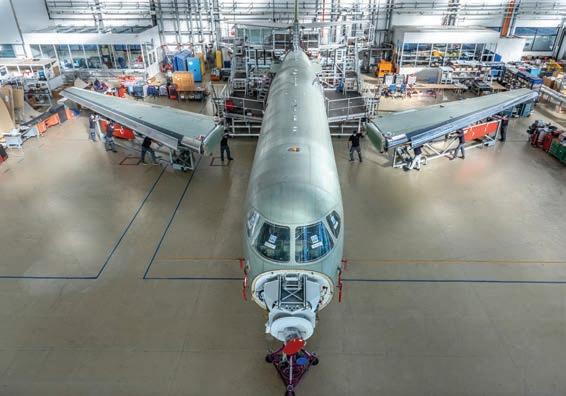
24 MEBAA Convention News • December 7, 2022 • ainonline.com
Final assembly of the 6X at Dassault’s Bordeaux-Mérignac factory in France.
Moscow’s Vnukovo-3 FBO has a market share of 30 to 40 percent of all business aviation flights in Russia.
Russian FBOs hoping for partial recovery in Q4
by Eugene Gerden
Russian FBOs are hoping for at least a par tial recovery in the fourth quarter after a sharp drop in traffic due to Ukraine warrelated sanctions imposed on Russia ear lier this year. As the Russian business avi ation industry was starting to recover after the pandemic, it was shocked in March by tightening sanctions against Russia for its aggression against Ukraine.
In March and April, business aircraft fly ing dropped about 75 percent year-over-year. While traffic began to gradually stabilize in the second quarter, the situation in the sec tor remains complex and most Russian FBOs continue to feel the pressure of the sanctions.
Business aviation infrastructure in Russia is still represented by specialized terminals only in Moscow and St. Petersburg. Among them are Vnukovo-3, the A-Group terminal in Sheremetyevo, UTG PA Business Aviation Center (Domodedovo), International Business Aviation Center in Ramenskoye, and Pulkovo-3 and A-Group Pulkovo in St. Petersburg.
As a rule, Russian FBOs do not disclose the results of their performance. According to the Russian Federal Air Transport Agency, Vnukovo-3 remains a market leader, account ing for about 30 to 40 percent of all business aviation flights in Russia.
The pandemic and economic fallout from the ongoing military conflict in Ukraine have had a negative effect on the performance of
Vnukovo-3 and other Russian FBOs this year.

As Vitaly Vantsev, a co-owner of Vnukovo-3, said in an interview with Russia’s RBC busi ness paper, despite the hobbling sanctions the industry still exists, although the percentage of flights from outside of Russia is insignifi cant. Prior to March, Vnukovo-3 was not only the most active FBO in Russia but one of the busiest in Europe. According to Vnukovo-3’s data, in the past there were 120 to 130 daily flights to the terminal, but now this figure is estimated at 30 to 40 flights. However, these are mainly domestic flights within Russia.
International business flights are mostly to and from countries friendly to Russia, which include Turkey, the United Arab Emirates, Maldives, Thailand, and others in Southeast Asia.
As for Vnukovo-3, 2021 was its most success ful in the last six years. The FBO served 17,340 flights and 105,800 thousand passengers—a 27 and 35 percent increase, respectively, com pared to 2020. Last year, traffic to international destinations accounted for about 65 percent of flights completed and passengers served at Vnukovo-3. In January, Russian market partici pants expected that the growth of the business flight market would continue in 2022, albeit at a more modest pace. Those projections were dashed by the international sanctions.
Meanwhile, other Russian FBOs are also suffering from Russia’s isolation. However, they are hoping that the beginning of the holiday period in the coming weeks will allow them to at least partially compensate for their huge losses in the current year. z
Jet Aviation adds heavy 777 maintenance at Basel facility
Jet Aviation’s Basel, Switzerland maintenance facility has received approval for heavy maintenance on the Boeing 777, extending its work scope for the widebody jet. The new approval also includes 15-year checks.
Jet Aviation (Stand 450) has purchased the specialized tools and invested in training for the heavy maintenance tasks on the 777, in response to market demand for the new capability. The Basel facil ity holds maintenance approval for more than 50 aircraft types and provides completions services for the 777, as well as all narrow- and widebody airframes.
With six hangars that total more than 36,700 sq m and 13,500 sq m of workshops, Jet Aviation Basel is an authorized maintenance facility for Airbus Corporate Jets, Boeing Business Jets, Embraer
Executive Jets, and Gulfstream Aerospace.
“Maintenance is one of our core businesses in EMEA,” said Jeremie Caillet, Jet Aviation’s senior v-p regional operations EMEA, “and this scope extension is a further example of our continued commitment to meet the evolving requirements of customers across our network.”
To continue serving its EMEA customers, Jet Aviation also announced an expansion of its maintenance, interiors, non-destruc tive testing (NDT), line maintenance, and on-site support capabili ties at its Dubai International Airport facility. This includes adding modular tail-docking equipment for heavy structural repairs, as well as new avionics modification and upgrade services and high-speed satcom installations. NDT services include eddy current ultrasonic and expanded on-site borescope inspection. M.T.
ainonline.com • December 7, 2022 • MEBAA Convention News 25
Bizav provides tools for growth in Middle East
 by Peter Shaw-Smith
by Peter Shaw-Smith
While the Middle East represents only about 5 percent of general aviation worldwide, the region is poised for growth given its size, the different businesses that exist, and the fact that companies typically have dealings in several countries in the region and increasingly have to connect to Europe, the U.S., and Asia. That’s according to Dassault Aviation inter national sales director Renaud Cloâtre, who is based in Dubai.
“Growth potential is enormous because the region is underequipped,” Cloâtre said. “If you look at general aviation’s structure in Europe or the U.S., there’s clear growth potential in the Mideast. We are in an economy where the energy market is actually changing relations between Europe, the U.S., and the Middle East. The value of oil is increasingly recognized. Oil prices are increasingly rele vant, underlining oil’s true value. It’s needed. There is also a requirement to use it wisely and not burn too much.
“Regional transition, as you’ve seen in Saudi Arabia and the UAE, as well as in
other countries, is taking place. The UAE has changed over the past 10 years. Change has taken place all over the region. When you move towards change, you need the tools for it, and business jets are one of them.”
He said the Falcon 7X—of which Dassault sold six to Saudia Private Aviation—has been a tremendous success. “The 7X and 8X are fantastic aircraft, going all the way from here to continents. People in Saudi Arabia love three-engine aircraft. They love the stability of fly-by-wire. The Saudi market is very com plex, in terms of actors and operators. It’s a big country, a big domestic market; it’s dis tance they need.
“Again, if you look at all the missions general aviation can perform—transporting people, goods and materials, or medical evacuation— many things are required in Saudi Arabia. Given the Vision 2030 plan and infrastructure changes in the kingdom, it will be a completely different proposition in years to come. That will give us big development opportunities.”
Setting aside the UAE and Saudi Arabia, he also sees opportunities elsewhere in the Gulf Cooperation Council (GCC). “It’s developing
and changing, and not just because oil pro vides the backbone,” Cloâtre said. “These countries are evolving. Regional transforma tion plans offer opportunities everywhere. I’ve also worked in Egypt, which has plenty of wealthy companies. Have you been to Cairo lately? New Cairo and the administrative capital are amazing.”
He said his work in the Middle East is a spread. “Let’s say we have activity in all these countries because we can actually respond to different missions in different countries—it’s government flights, private flights, or special missions. It’s an entire portfolio. You’ve got the GCC and up to Pakistan. Then it’s from Turkey to Egypt. Israel is not my territory. There’s always a need, somewhere,” he said.
Turkey has also proved to be an excellent market for Dassault. “Istanbul is a very good market,” he said. “We have a strong presence in Turkey. The Falcon 6X had a very good reception. The 6X has significant experience in Turkey with long-time owners, who have also availed themselves of the wider Fal con portfolio.”
Face-to-face
Cloâtre said the pandemic had been a period of ups and downs, with the regional econ omy fluctuating.
“Covid showed that you cannot just rely on your computer and say: ‘Okay, I’ve got Zoom, I’ve got Skype, I’ve got whatever, and I can do my business from home,’” he said. “That’s not
26 MEBAA Convention News • December 7, 2022 • ainonline.com
8X
DAVID M c INTOSH
Falcon
really the case. You have to be on-site talking about business. You have to be able to check what’s going on at your facilities on the other side of the world; you have to deal with your client and you have to interact. Covid showed that private aviation is a very strong tool, not only for business. We’ve seen the sanitary measures taken by Dassault in France and in Europe. Although unseen, these are an important part of aviation.”
He underlined the ability of the Falcon 8X, which is on static display this week at MEBAA 2022 (Static A21), to fly from New York or Washington direct to Abu Dhabi. The 10X, o ffi cially due for delivery in late 2025, will be an even better option. “On the way back, when the headwinds get stronger, you need the 7,500-nautical-mile range of the 10X, if you want to do it nonstop,” he said. “Otherwise, you make a 30-minute fuel and customs stop in Shannon, and you can fly fast between the stops.”
Dassault has noted that its large-cabin models such as the 6,450-nm Falcon 8X com prise a third of the 75 Falcons in the region. That fleet is expected to grow once the Falcon 6X and 10X reach the market in coming years.
The Falcon 6X is due to enter service in mid-2023. “You have a mix of demand, for which the 6X is ideal,” he said. “It can per form a variety of missions, from long-range to short-range, but the key is that it takes you to your destination. Given generations of our clients, what’s more important today, apart from avoiding distress, is the journey from door to door. In a single day, you can, for example, have meetings in three cities. Most impor tantly, the Falcon offers valuable flexibility.”
Dassault has received strong interest, including a “significant number of orders” from the Middle East for the 6X. Several deliveries are lined up to the region shortly after the wide-cabin model enters service, the French airframer said, adding the 6X is in the final stages of flight testing.
As its fleet continues to grow, Dassault Aviation is expanding its service capabilities in the region. In 2019, Dassault acquired the worldwide maintenance activities of Luxavia tion subsidiary ExecuJet, which plans to open a 15,000-sq-m (163,000-sq-ft) FBO/MRO at Dubai Al Maktoum International Airport (OMDW) early next year.
Serving operators in the Gulf region, the facility at OMDW will be able to accommo date between 18 and 24 aircraft simultane ously and will be qualified to handle a full
range of MRO activities, from line mainte nance to major overhauls.
ExecuJet will offer services for other OEM aircraft in addition to Falcons, including both regionally-based and in-transit aircraft. To serve as ExecuJet’s regional headquarters, the complex is replacing ExecuJet’s base mainte nance at Dubai International Airport (OMDB). However, the OMDB location will continue to provide AOG services.
“We have a strong investment in OMDW with our three hangars,” he said. “This
investment aims to bring us closer to our cli ents in terms of maintenance; clients can go to Dassault Dubai as easily as to Paris Dassault Falcon Service. The development of OMDW— the initial OMDW master plan—is gradually bearing fruit. There’s certainly a transition from OMDB to OMDW. I think the govern ment has phased it well. It’s a transition which I welcome.”
Dassault also has a spare parts distribution center in Dubai and added an engineering office in Cairo. z
Empire adds Boeing BBJ to charter fleet

Aircraft management, sales, and charter specialist Empire Aviation Group (EAG, Static S4) has added a Boeing Business Jet to its fleet, increasing to 20 the number of business jets it manages. The company has inducted more than 70 aircraft in its 15-year history. EAG is operating the BBJ on behalf of its Dubai-based owner.
On the eve of MEBAA, EAG founder and managing director Paras Dhamecha told AIN that EAG had seen its charter business increase 200 percent year-to-date versus 2019 as aircraft availability for charter now is at a premium in the region. For this rea son, EAG will have plenty to celebrate this week at MEBAA 2022.
EAG has become one of the largest air craft management and charter operators in the UAE and also manages a sales o ce in the U.S., with activities in India, West Africa, and Asia. The company holds an air operator certificate from the UAE General Civil Aviation Authority and certification of registration with the San Marino Civil Avia tion Authority. EAG’s a liate in Bangalore, Empire Aircraft Management Services, holds
a non-scheduled charter operator’s permit in India.
Aircraft sales are also a growing seg ment for the company, and it is marketing a portfolio of Gulfstream, Bombardier, Das sault, and Embraer aircraft. In 2021, Gulf stream appointed EAG as its international sales representative in India.
In addition to its other services, EAG also o ers continuing airworthiness man agement organization services to its air craft owners and also third party owners and operators.
“Empire Aviation has successfully devel oped into a reputable and award-winning global private aviation service provider to aircraft owners and charter clients, thanks to the team and the support of all our part ners,” said Dhamecha.
“There is no doubt that we have benefit ted from Dubai and the UAE’s position as an international aviation hub with world-class infrastructure, facilities, and regulators. Our journey continues, and the exciting addition of the BBJ quite literally adds a new dimension,” he concluded. P.S.-S.
ainonline.com • December 7, 2022 • MEBAA Convention News 27
The addition of this Boeing Business Jet brings Empire Aviation Group’s fleet to 20 aircraft.
Duncan Aviation broadens reach to Middle East
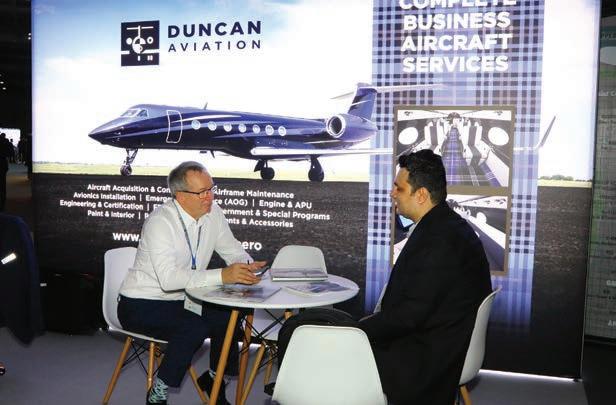 by Jerry Siebenmark
by Jerry Siebenmark
Business aircraft maintenance provider Dun can Aviation is using the 2022 MEBAA Show this week as a platform to meet with current and past clients and “to evaluate and explore possible opportunities in the future and to share our brand image, which is synonymous with high-quality work, responsive customer service, and a wide range of capabilities within the region.” While it is one of the larger independent MROs in the U.S, the Lincoln, Nebraska-based company has forged business relationships with business aircraft owners and operators in the Middle East over several years.
Phil Suglia, Duncan sales manager, told AIN
that the company (Stand 855) holds certifi cations and authorizations to perform work from 13 aviation regulators, including authorities in India and the United Arab Emirates.
“These facilities perform high-quality, noseto-tail services on the most popular business aircraft in flight today,” he said. “We consis tently work with business aircraft manage ment companies and owner/operators from the Middle East and North Africa region.”
The company’s capabilities include major and minor airframe inspections, engine maintenance, major retrofits for cabin and cockpit avionics systems, full paint and interior ser vices, engineering and certification services,
fabrication and manufacturing services, and preowned aircraft sales and acquisitions.
Duncan’s aircraft sales and acquisi tions department regularly works with MEBAA-member clients, as does its parts and rotables support division, which provides parts and components to operators worldwide. “Duncan Aviation does regularly provide sup port for Middle East maintenance providers, developing relationships and brand recognition to support their clients with the more intensive inspections and MRO projects that cannot be serviced regionally and that would require relo cation of an aircraft to Duncan Aviation facili ties in the United States,” Suglia said. z
Atlas Air serves variety of customers
Germany-based Atlas Air Service Group comes to the 2022 MEBAA Show as a bigger company with increased capabilities follow ing its January acquisition of AAL (Stand 750), formerly Altenrhein Aviation, a business avi ation maintenance company based in Swit zerland. The acquisition of 100 percent of the shares of AAL expanded the companies’ AOG services and improved spare parts availabil ity, as well as access to test equipment and more tools.
With the AAL acquisition, Atlas Group companies employ 280 people and operate from five locations, which includes Augsburg Air Service, also in Germany. Combined, the companies provide aircraft management and charter, sales, maintenance, avionics, and non-destructive testing. On the maintenance
side, AAL, Atlas, and Augsburg also have capa bilities in sheet metal repair, full interior refur bishment, and paint.
The three group companies have service center authorizations from Embraer, Cessna, Beechcraft, Hawker, Honeywell, Cirrus, Piper, Gulfstream, Daher, Pilatus, and Williams International. In addition to operating as FAA and EASA repair stations, the companies are approved by regulators in Bermuda, Canada, Cayman Islands, Guernsey, India, Isle of Man, Nigeria, Russia, San Marino, and the UK.
AAL managing director Natascha Rode told AIN that AAL specializes in heavy main tenance on the Gulfstream G150, G200, and G280 and Embraer jets, aircraft for which it is an authorized service center (ASC). “As an Embraer ASC, we have regular customers
coming from Africa for major inspections,” she said. “Over the years, AAL technicians have performed numerous 8C, 12C, and 16C inspections. It is not unusual that custom ers from the Middle East and Asia would ferry their aircraft to Switzerland for such complex maintenance.”
More recently, AAL has seen an increase in pre-purchase inspections. “It is common knowledge that the aircraft’s value is higher if the last major inspection was performed in an authorized service center,” Rode said. She further noted that AAL, Atlas, and Augsburg are accustomed to working with clients from a variety of cultures. “Our employees under stand different cultures and by extending our hospitality, we guarantee our customers an ‘at-home’ feeling.”
J.S.
28 MEBAA Convention News • December 7, 2022 • ainonline.com
Duncan Aviation sees growing interest in its maintenance support from Middle East and North Africa operators.
DAVID M c INTOSH
Gulf region
to be an early adopter of eVTOL vehicles. According to Falcon COO Raman Oberoi, Eve—which is majority-owned by Brazilian aircraft manufacturer Embraer following an initial public offering on the New York Stock Exchange—approached Falcon with the pro posal to launch services in the Gulf region.
Abu Dhabi-based Falcon is planning to operate the eVTOLs initially from its existing heliport at Atlantis the Palm, from where it offers tourists a bird’s-eye view of Dubai. In 2021, the heliport was used by 45,000 passengers taking sightseeing rides from the island site. In 2019, Falcon announced plans, in partnership with helicopter maker Leonardo, to develop vertiports in the region.
Airport Shuttle
The Eve aircraft also has the potential to appeal to travelers moving to and from the VIP terminal at Dubai Al Maktoum Interna tional Airport. Helicopter shuttles from Fal con’s heliport at that site have yet to take off due to the failure to effectively compete with limousine service, Oberoi said.
In October, China’s Xpeng chose Dubai as the site for the international debut of its X2 “flying car,” which is primarily intended for personal transportation by owner-pilots. While the X2 has no wheels and looks more like one of the commercial eVTOL designs, Xpeng is also working on a model called the X3 that is more car-like and has eight retractable propellers that might appeal to high-net-worth Emiratis.
AAM expansion will also require significant investment in new ground infrastructure. Last month at Abu Dhabi Air Expo, French airports group ADP signed a memorandum of under standing with Abu Dhabi Airports to jointly prepare to build a network of vertiports in the emirate. ADP is already involved in a consor tium working to launch eVTOL air services in the French capital during the 2024 Paris Olympic Games.
Meanwhile, the UAE’s neighbor, Saudi Arabia, also has ambitions to be a significant player in the AAM sector. The most recent development, in October, saw Saudi Arabian Airlines (Saudia) sign a deal with Lilium to acquire 100 of the company’s seven-passenger Lilium Jet aircraft.
The memorandum of understanding covers plans for the Saudi flag carrier to operate an
UAE operator Falcon Aviation plans to use Eve’s four-passenger eVTOL aircraft for air taxi services starting with flights from Atlantis the Palm resort.
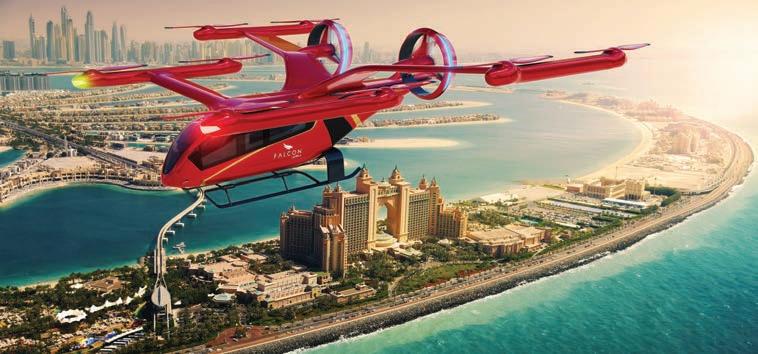
eVTOL air-taxi network across the country. The airline will help Germany-based Lilium to secure local type certification for its aircraft, as well as operational approvals.
Saudia said its purchase will accompany new electric point-to-point connections and seam less feeder connections to its hubs for business-class passengers. Lilium promotes the Lilium Jet’s flexible cabin architecture as ideal for meeting the needs of the premium market, which it believes can help drive the early adop tion of eVTOLs in the discerning Gulf market.
Originally expecting to win certification of the Lilium Jet in 2024, Lilium in March said it pushed back the projected timeline to achieve approval by potentially 12 or more months into 2025. Several new eVTOLs are expected to enter commercial service that same year, including Archer’s Midnight, Joby’s unnamed model, and the Vertical Aerospace VX4—all of which will carry four passengers.
Neom Service
The Lilium deal follows a separate agreement announced last December between the Neom regional development project in the north west of Saudi Arabia and Volocopter. This is aimed at launching urban air mobility services by 2024 with 10 of the German company’s two-seat VoloCity aircraft and five fully autonomous VoloDrone cargo-carrying vehicles.
Under the agreement signed, the partners plan to develop what they called a public vertical mobility system in Neom on the country’s Red Sea coast. Plans call for the development of an “industrial city” called Oxagon and a residential community called The Line that will extend for slightly more than 100 miles and house a population of one million people.
Developers claim the communities will
be powered entirely from renewable energy sources with “zero cars, zero streets, and zero carbon emissions.” However, plans initiated in 2019 also call for the building of a new international airport.
The venture will be the sole operator of initial public transit services across Neom, which covers 10,200 sq mi and is being devel oped with a budget of $500 billion as part of a Saudi government plan to reduce its economic dependence on oil revenues. The partners said infrastructure will be developed in a way that can be used by other types of eVTOLs, and rival companies will be able to provide services such as logistics and emergency response.
Last month, Neom stepped up its commit ment to Volocopter in backing a $182 million Series E funding round. The campaign was jointly supported by Hong Kong’s Gly Capi tal Management, which is part of the Chinese automotive group Geely.
Meanwhile, the UAE’s Tawazun Economic Council is supporting efforts by Cranfield Aerospace Solutions to convert existing aircraft—such as the nine-passenger Brit ten-Norman Islander—to hydrogen propul sion. The council, which is the defense and security acquisitions authority for the UAE Armed Forces and Abu Dhabi Police, backed a £14.4 million ($16.8 million) funding round for the UK company, which is also working on plans to develop a hydrogen-powered 19-seat regional airliner.
Today at the MEBAA show, a conference series titled “Tomorrow’s Customer–Next Generation” includes a session on prospects for eVTOL air services. It will be led by U.S.based Odys Aviation, which is working on plans for a hybrid-electric eVTOL model with an eye-catching blown-wing design. z
ainonline.com • December 7, 2022 • MEBAA Convention News 29
continued from page 1
World Fuel sees Middle East surge
by Curt Epstein
As the MEBAA Show makes its triumphant return after a Covid-induced pause, business aviation activity in the Middle East region has been riding the same post-pan demic surge seen in other regions, according to World Fuel Services (Stand 1120).

“The Middle East came out of Covid more quickly than Europe,” said James Hardacre, the U.S.based company’s v-p of business aviation sales for Europe and the Middle East. “It was quicker to start the bounce [back] and it looks like the bounce is lasting longer in the Middle East when I compare it to Europe at least.”
He noted that while growth in some regions is showing signs of slowing down, the Middle East is continuing to show strength. “Year-todate just versus last year alone, Middle East departure activity is up around 15 percent, and that’s on 2021 which was a solid year in itself,” he explained. “Generally, the Middle East has been pretty similarly aligned to the European market for [business and general aviation] in
terms of growth, but it’s actually outgrown Europe this year.”
Hardacre added that while charter activity drove the initial post-pandemic growth, that paradigm has shifted. “You are starting to see the slowdown across the aircraft management and charter side of the business,” he told AIN. “In terms of longevity, whereas char ter has started to dip, private and corporate is stronger presently.”
THE EDITORIAL TEAM
Charles Alcock
PRODUCTION MANAGER Martha Jercinovich
GRAPHIC DESIGNERS – Alena Korenkov, John A. Manfredo, Grzegorz Rzekos
PHOTOGRAPHER – David McIntosh
DIRECTOR OF VIDEO Ian Whelan
CHIEF OPERATING OFFICER Dave Leach
VICE PRESIDENT SALES & MARKETING Karl H. Elken
James Hardacre, World Fuel Services v-p of business aviation sales for Europe, Middle East

The company is able to take a wide view of the local market due to its presence at more than 1,000 locations throughout the region. “I would be quite comfortable to say we supply almost every air port where there is a material fuel demand across the board,” said Riyan Qirbi, World Fuel’s direc tor of market development for the region. “The two points that we try to focus on: are we reliable in terms of our supply and is the fuel being supplied to a very high standard and according to the best international practices?”
While World Fuel does not provide actual fuel handling for its customers, it serves a vital role in making sure they are able to operate throughout the region. “We’re able to basi cally operate on what we call a back-to-back basis, so we arrange fuel supply for our cus tomers and we deal with the entire interface with the supplier who actually does the intoplane part for the customer,” said Qirbi.
This week at MEBAA 2022, the company is sharing its exhibit stand with UK-based Har rods Aviation, which is a member of the World Fuel-sponsored Air Elite network of global upscale FBOs. Harrods operates facilities at London Luton and Stansted airports.
SENIOR DIRECTOR, INDUSTRY AFFAIRS AND EVENTS Nancy O’Brien
ADVERTISING SALES
Michelle James Midwestern U.S., Western U.S./Western Canada/Asia Pacific, +1 (520) 343-0236
Joe Rosone – Mid-Atlantic U.S./Southeast U.S./Caribbean/ Brazil, +1 (301) 693-4687
Diana Scogna Europe/Middle East, +33 6 62 52 25 47
Victoria Tod Northeastern U.S./Eastern Canada/Great Lakes U.S./United Kingdom, +1 (203) 733-4184
Yury Laskin Russia, +7 05 912 1346
AUDIENCE DEVELOPMENT DIRECTOR Eileen Silberfeld
MARKETING AND CLIENT SERVICES MANAGER – Lisa Valladares
SOCIAL MEDIA MARKETING Zach O’Brien
SALES ADMINISTRATOR – Cindy Nesline
DIRECTOR OF FINANCE & HUMAN RESOURCES – Michele Hubert ACCOUNTS PAYABLE – Mary Avella ACCOUNTS RECEIVABLE – Bobbie Bing
U.S. HEADQUARTERS:
214 Franklin Ave., Midland Park, NJ 07432, +1 (201) 444-5075
Advertising Inquiries: +1 (201) 345-0085, adsales@ainonline.com Circulation Inquiries: +1 (201) 345-0085 subscriptions@ainonline.com
WASHINGTON, D.C. EDITORIAL OFFICE: Kerry Lynch (business aviation) klynch@ainonline.com +1 (703) 969-9195
EUROPEAN EDITORIAL OFFICE: Charles Alcock calcock@ainonline.com, Tel: +44 7799 907595
MEBAA Convention News is a publication of the AIN Media Group, Inc., 214 Franklin Ave., Midland Park, NJ 07432; Tel.: +1 (201) 444-5075. Copy right © 2021 All rights reserved. Reproduction in whole or in part with out permission of AIN Media Group, Inc. is strictly prohibited. AIN Media Group, Inc. publishes Aviation International News, AINalerts, AIN Air Transport Perspective, Business Jet Traveler, BJTwaypoints, ABACE Convention News, Dubai Airshow News, EBACE Convention News, Farnborough Airshow News, FutureFlight.aero, HAI Convention News, LABACE Convention News, NBAA Convention News, Paris Airshow News, Singapore Airshow News, Mobile Apps: Aviation International News; AINonline. PUBLICATION MAIL AGREEMENT NO. 40649046
“They’ll tell their story of how they fit in with what we’re doing,” explained Peter Ste vens, the Miami-based fuel provider’s v-p of global marketing for aviation and marine. “This is part of the value we provide to the [FBO] locations that we have is taking their message forward and helping them present it to bigger audiences.”
THE CONVENTION NEWS COMPANY, INC. AIN PUBLICATIONS EXECUTIVE TEAM
z
30 MEBAA Convention News • December 7, 2022 • ainonline.com
JAMES HOLAHAN (1921 2015), FOUNDING EDITOR WILSON S. LEACH, FOUNDER & CEO
EDITOR IN CHIEF – Matt Thurber PRESS ROOM EDITOR – Chad Trautvetter
Curt Epstein Eugene Gergen Mark Huber
Kerry Lynch Gregory Polek Kate Sarsfield Jerry Siebenmark
Peter Shaw-Smith James Wynbrandt Hanneke Weitering
RETURN UNDELIVERABLE CANADIAN ADDRESSES TO: PIT NEY BOWES INTERNATIONAL MAIL, STATION A, P.O. BOX 54, WINDSOR, ON, N9A 6J5, returns il@imex.pb.com.
Jennifer
Matt
Dave
Michele
Wilson Leach
Leach English Karl H. Elken
Thurber
Leach
Hubert Nancy O’Brien
CONVENTION NEWS
Printed by Emirates Printing Press L.L.C., Dubai MEBAA
Harrods is a member of the Air Elite FBO
ALENA KORENKOV
network.



SCAN ME BOOK YOUR STAND Don’t be left in transit! PARIS AIR SHOW is boardingnow 19 > 25 JUNE 2023 WHERE AEROSPACE LEADERS GET DOWN TO BUSINESS

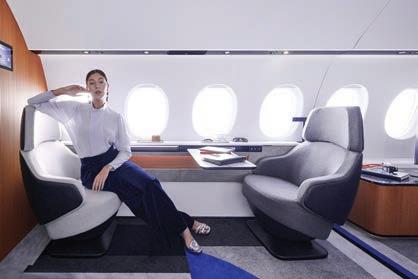
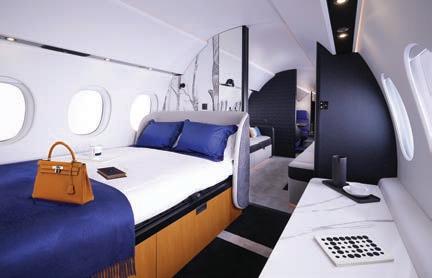

Experience the largest cabin volume of any business jet. The most layout flexibility. The most advanced flight technology and cabin environment. Go farther, faster. Up to 7,500 nm, up to Mach .925. Falcon 10X. A perfect ten. YOU GO THE EXTRA MILE. GO FOR THE EXTRA SPACE. WWW DASSAULTFALCON.COM I FRANCE: +33 1 47 11 88 68 I DUBAI: +971 4 299 3950
 by Charles Alcock
by Charles Alcock








































































































 by Peter Shaw-Smith
by Peter Shaw-Smith






 by Peter Shaw-Smith
by Peter Shaw-Smith


 by Matt Thurber
by Matt Thurber




 by Peter Shaw-Smith
by Peter Shaw-Smith

 by Jerry Siebenmark
by Jerry Siebenmark









